#In today's data-driven world
Explore tagged Tumblr posts
Text
What Are the Qualifications for a Data Scientist?
In today's data-driven world, the role of a data scientist has become one of the most coveted career paths. With businesses relying on data for decision-making, understanding customer behavior, and improving products, the demand for skilled professionals who can analyze, interpret, and extract value from data is at an all-time high. If you're wondering what qualifications are needed to become a successful data scientist, how DataCouncil can help you get there, and why a data science course in Pune is a great option, this blog has the answers.
The Key Qualifications for a Data Scientist
To succeed as a data scientist, a mix of technical skills, education, and hands-on experience is essential. Here are the core qualifications required:
1. Educational Background
A strong foundation in mathematics, statistics, or computer science is typically expected. Most data scientists hold at least a bachelor’s degree in one of these fields, with many pursuing higher education such as a master's or a Ph.D. A data science course in Pune with DataCouncil can bridge this gap, offering the academic and practical knowledge required for a strong start in the industry.
2. Proficiency in Programming Languages
Programming is at the heart of data science. You need to be comfortable with languages like Python, R, and SQL, which are widely used for data analysis, machine learning, and database management. A comprehensive data science course in Pune will teach these programming skills from scratch, ensuring you become proficient in coding for data science tasks.
3. Understanding of Machine Learning
Data scientists must have a solid grasp of machine learning techniques and algorithms such as regression, clustering, and decision trees. By enrolling in a DataCouncil course, you'll learn how to implement machine learning models to analyze data and make predictions, an essential qualification for landing a data science job.
4. Data Wrangling Skills
Raw data is often messy and unstructured, and a good data scientist needs to be adept at cleaning and processing data before it can be analyzed. DataCouncil's data science course in Pune includes practical training in tools like Pandas and Numpy for effective data wrangling, helping you develop a strong skill set in this critical area.
5. Statistical Knowledge
Statistical analysis forms the backbone of data science. Knowledge of probability, hypothesis testing, and statistical modeling allows data scientists to draw meaningful insights from data. A structured data science course in Pune offers the theoretical and practical aspects of statistics required to excel.
6. Communication and Data Visualization Skills
Being able to explain your findings in a clear and concise manner is crucial. Data scientists often need to communicate with non-technical stakeholders, making tools like Tableau, Power BI, and Matplotlib essential for creating insightful visualizations. DataCouncil’s data science course in Pune includes modules on data visualization, which can help you present data in a way that’s easy to understand.
7. Domain Knowledge
Apart from technical skills, understanding the industry you work in is a major asset. Whether it’s healthcare, finance, or e-commerce, knowing how data applies within your industry will set you apart from the competition. DataCouncil's data science course in Pune is designed to offer case studies from multiple industries, helping students gain domain-specific insights.
Why Choose DataCouncil for a Data Science Course in Pune?
If you're looking to build a successful career as a data scientist, enrolling in a data science course in Pune with DataCouncil can be your first step toward reaching your goals. Here’s why DataCouncil is the ideal choice:
Comprehensive Curriculum: The course covers everything from the basics of data science to advanced machine learning techniques.
Hands-On Projects: You'll work on real-world projects that mimic the challenges faced by data scientists in various industries.
Experienced Faculty: Learn from industry professionals who have years of experience in data science and analytics.
100% Placement Support: DataCouncil provides job assistance to help you land a data science job in Pune or anywhere else, making it a great investment in your future.
Flexible Learning Options: With both weekday and weekend batches, DataCouncil ensures that you can learn at your own pace without compromising your current commitments.
Conclusion
Becoming a data scientist requires a combination of technical expertise, analytical skills, and industry knowledge. By enrolling in a data science course in Pune with DataCouncil, you can gain all the qualifications you need to thrive in this exciting field. Whether you're a fresher looking to start your career or a professional wanting to upskill, this course will equip you with the knowledge, skills, and practical experience to succeed as a data scientist.
Explore DataCouncil’s offerings today and take the first step toward unlocking a rewarding career in data science! Looking for the best data science course in Pune? DataCouncil offers comprehensive data science classes in Pune, designed to equip you with the skills to excel in this booming field. Our data science course in Pune covers everything from data analysis to machine learning, with competitive data science course fees in Pune. We provide job-oriented programs, making us the best institute for data science in Pune with placement support. Explore online data science training in Pune and take your career to new heights!
#In today's data-driven world#the role of a data scientist has become one of the most coveted career paths. With businesses relying on data for decision-making#understanding customer behavior#and improving products#the demand for skilled professionals who can analyze#interpret#and extract value from data is at an all-time high. If you're wondering what qualifications are needed to become a successful data scientis#how DataCouncil can help you get there#and why a data science course in Pune is a great option#this blog has the answers.#The Key Qualifications for a Data Scientist#To succeed as a data scientist#a mix of technical skills#education#and hands-on experience is essential. Here are the core qualifications required:#1. Educational Background#A strong foundation in mathematics#statistics#or computer science is typically expected. Most data scientists hold at least a bachelor’s degree in one of these fields#with many pursuing higher education such as a master's or a Ph.D. A data science course in Pune with DataCouncil can bridge this gap#offering the academic and practical knowledge required for a strong start in the industry.#2. Proficiency in Programming Languages#Programming is at the heart of data science. You need to be comfortable with languages like Python#R#and SQL#which are widely used for data analysis#machine learning#and database management. A comprehensive data science course in Pune will teach these programming skills from scratch#ensuring you become proficient in coding for data science tasks.#3. Understanding of Machine Learning
3 notes
·
View notes
Text
Your Guide to B.Tech in Computer Science & Engineering Colleges

In today's technology-driven world, pursuing a B.Tech in Computer Science and Engineering (CSE) has become a popular choice among students aspiring for a bright future. The demand for skilled professionals in areas like Artificial Intelligence, Machine Learning, Data Science, and Cloud Computing has made computer science engineering colleges crucial in shaping tomorrow's innovators. Saraswati College of Engineering (SCOE), a leader in engineering education, provides students with a perfect platform to build a successful career in this evolving field.
Whether you're passionate about coding, software development, or the latest advancements in AI, pursuing a B.Tech in Computer Science and Engineering at SCOE can open doors to endless opportunities.
Why Choose B.Tech in Computer Science and Engineering?
Choosing a B.Tech in Computer Science and Engineering isn't just about learning to code; it's about mastering problem-solving, logical thinking, and the ability to work with cutting-edge technologies. The course offers a robust foundation that combines theoretical knowledge with practical skills, enabling students to excel in the tech industry.
At SCOE, the computer science engineering courses are designed to meet industry standards and keep up with the rapidly evolving tech landscape. With its AICTE Approved, NAAC Accredited With Grade-"A+" credentials, the college provides quality education in a nurturing environment. SCOE's curriculum goes beyond textbooks, focusing on hands-on learning through projects, labs, workshops, and internships. This approach ensures that students graduate not only with a degree but with the skills needed to thrive in their careers.
The Role of Computer Science Engineering Colleges in Career Development
The role of computer science engineering colleges like SCOE is not limited to classroom teaching. These institutions play a crucial role in shaping students' futures by providing the necessary infrastructure, faculty expertise, and placement opportunities. SCOE, established in 2004, is recognized as one of the top engineering colleges in Navi Mumbai. It boasts a strong placement record, with companies like Goldman Sachs, Cisco, and Microsoft offering lucrative job opportunities to its graduates.
The computer science engineering courses at SCOE are structured to provide a blend of technical and soft skills. From the basics of computer programming to advanced topics like Artificial Intelligence and Data Science, students at SCOE are trained to be industry-ready. The faculty at SCOE comprises experienced professionals who not only impart theoretical knowledge but also mentor students for real-world challenges.
Highlights of the B.Tech in Computer Science and Engineering Program at SCOE
Comprehensive Curriculum: The B.Tech in Computer Science and Engineering program at SCOE covers all major areas, including programming languages, algorithms, data structures, computer networks, operating systems, AI, and Machine Learning. This ensures that students receive a well-rounded education, preparing them for various roles in the tech industry.
Industry-Relevant Learning: SCOE’s focus is on creating professionals who can immediately contribute to the tech industry. The college regularly collaborates with industry leaders to update its curriculum, ensuring students learn the latest technologies and trends in computer science engineering.
State-of-the-Art Infrastructure: SCOE is equipped with modern laboratories, computer centers, and research facilities, providing students with the tools they need to gain practical experience. The institution’s infrastructure fosters innovation, helping students work on cutting-edge projects and ideas during their B.Tech in Computer Science and Engineering.
Practical Exposure: One of the key benefits of studying at SCOE is the emphasis on practical learning. Students participate in hands-on projects, internships, and industry visits, giving them real-world exposure to how technology is applied in various sectors.
Placement Support: SCOE has a dedicated placement cell that works tirelessly to ensure students secure internships and job offers from top companies. The B.Tech in Computer Science and Engineering program boasts a strong placement record, with top tech companies visiting the campus every year. The highest on-campus placement offer for the academic year 2022-23 was an impressive 22 LPA from Goldman Sachs, reflecting the college’s commitment to student success.
Personal Growth: Beyond academics, SCOE encourages students to participate in extracurricular activities, coding competitions, and tech fests. These activities enhance their learning experience, promote teamwork, and help students build a well-rounded personality that is essential in today’s competitive job market.
What Makes SCOE Stand Out?
With so many computer science engineering colleges to choose from, why should you consider SCOE for your B.Tech in Computer Science and Engineering? Here are a few factors that make SCOE a top choice for students:
Experienced Faculty: SCOE prides itself on having a team of highly qualified and experienced faculty members. The faculty’s approach to teaching is both theoretical and practical, ensuring students are equipped to tackle real-world challenges.
Strong Industry Connections: The college maintains strong relationships with leading tech companies, ensuring that students have access to internship opportunities and campus recruitment drives. This gives SCOE graduates a competitive edge in the job market.
Holistic Development: SCOE believes in the holistic development of students. In addition to academic learning, the college offers opportunities for personal growth through various student clubs, sports activities, and cultural events.
Supportive Learning Environment: SCOE provides a nurturing environment where students can focus on their academic and personal growth. The campus is equipped with modern facilities, including spacious classrooms, labs, a library, and a recreation center.
Career Opportunities After B.Tech in Computer Science and Engineering from SCOE
Graduates with a B.Tech in Computer Science and Engineering from SCOE are well-prepared to take on various roles in the tech industry. Some of the most common career paths for CSE graduates include:
Software Engineer: Developing software applications, web development, and mobile app development are some of the key responsibilities of software engineers. This role requires strong programming skills and a deep understanding of software design.
Data Scientist: With the rise of big data, data scientists are in high demand. CSE graduates with knowledge of data science can work on data analysis, machine learning models, and predictive analytics.
AI Engineer: Artificial Intelligence is revolutionizing various industries, and AI engineers are at the forefront of this change. SCOE’s curriculum includes AI and Machine Learning, preparing students for roles in this cutting-edge field.
System Administrator: Maintaining and managing computer systems and networks is a crucial role in any organization. CSE graduates can work as system administrators, ensuring the smooth functioning of IT infrastructure.
Cybersecurity Specialist: With the growing threat of cyberattacks, cybersecurity specialists are essential in protecting an organization’s digital assets. CSE graduates can pursue careers in cybersecurity, safeguarding sensitive information from hackers.
Conclusion: Why B.Tech in Computer Science and Engineering at SCOE is the Right Choice
Choosing the right college is crucial for a successful career in B.Tech in Computer Science and Engineering. Saraswati College of Engineering (SCOE) stands out as one of the best computer science engineering colleges in Navi Mumbai. With its industry-aligned curriculum, state-of-the-art infrastructure, and excellent placement record, SCOE offers students the perfect environment to build a successful career in computer science.
Whether you're interested in AI, data science, software development, or any other field in computer science, SCOE provides the knowledge, skills, and opportunities you need to succeed. With a strong focus on hands-on learning and personal growth, SCOE ensures that students graduate not only as engineers but as professionals ready to take on the challenges of the tech world.
If you're ready to embark on an exciting journey in the world of technology, consider pursuing your B.Tech in Computer Science and Engineering at SCOE—a college where your future takes shape.
#In today's technology-driven world#pursuing a B.Tech in Computer Science and Engineering (CSE) has become a popular choice among students aspiring for a bright future. The de#Machine Learning#Data Science#and Cloud Computing has made computer science engineering colleges crucial in shaping tomorrow's innovators. Saraswati College of Engineeri#a leader in engineering education#provides students with a perfect platform to build a successful career in this evolving field.#Whether you're passionate about coding#software development#or the latest advancements in AI#pursuing a B.Tech in Computer Science and Engineering at SCOE can open doors to endless opportunities.#Why Choose B.Tech in Computer Science and Engineering?#Choosing a B.Tech in Computer Science and Engineering isn't just about learning to code; it's about mastering problem-solving#logical thinking#and the ability to work with cutting-edge technologies. The course offers a robust foundation that combines theoretical knowledge with prac#enabling students to excel in the tech industry.#At SCOE#the computer science engineering courses are designed to meet industry standards and keep up with the rapidly evolving tech landscape. With#NAAC Accredited With Grade-“A+” credentials#the college provides quality education in a nurturing environment. SCOE's curriculum goes beyond textbooks#focusing on hands-on learning through projects#labs#workshops#and internships. This approach ensures that students graduate not only with a degree but with the skills needed to thrive in their careers.#The Role of Computer Science Engineering Colleges in Career Development#The role of computer science engineering colleges like SCOE is not limited to classroom teaching. These institutions play a crucial role in#faculty expertise#and placement opportunities. SCOE#established in 2004#is recognized as one of the top engineering colleges in Navi Mumbai. It boasts a strong placement record
2 notes
·
View notes
Text

🚀 Step Into the World of Digital Marketing with DMA Digital Marketing Academy! 🌟 💡 Ready to start your digital career and explore endless opportunities? With DMA, you'll build the foundation for success, learn cutting-edge strategies, and earn globally recognized certifications. 🎯 What You'll Learn: ✅ Master essential skills like SEO, SMM, SEM, Email Marketing, and Analytics. ✅ Understand consumer behavior and spot trends. ✅ Create data-driven campaigns that deliver impactful results. 🎓 Get Certified in: ⭐ Google Ads | ⭐ HubSpot Content Marketing ⭐ Facebook Blueprint | ⭐ Hootsuite Social Marketing ⭐ Google Analytics 💼 Why Wait? Take the Success Path Today! 📞 Call us now at: +91-9045922719 | +91-8077561199 📢 Let DMA Digital Marketing Academy guide you toward your dream career. Your success starts NOW! 🚀 #meerut #dmamidas #midaspiyush #seo #smo #job #Digital_marketing #institute_in_meerut #best_digital_marketing_institute_in_meerut #digital_career #SEM #google_ads
#🚀 Step Into the World of Digital Marketing with DMA Digital Marketing Academy! 🌟#💡 Ready to start your digital career and explore endless opportunities? With DMA#you'll build the foundation for success#learn cutting-edge strategies#and earn globally recognized certifications.#🎯 What You'll Learn:#✅ Master essential skills like SEO#SMM#SEM#Email Marketing#and Analytics.#✅ Understand consumer behavior and spot trends.#✅ Create data-driven campaigns that deliver impactful results.#🎓 Get Certified in:#⭐ Google Ads | ⭐ HubSpot Content Marketing#⭐ Facebook Blueprint | ⭐ Hootsuite Social Marketing#⭐ Google Analytics#💼 Why Wait? Take the Success Path Today!#📞 Call us now at: +91-9045922719 | +91-8077561199#📢 Let DMA Digital Marketing Academy guide you toward your dream career. Your success starts NOW! 🚀#meerut#dmamidas#midaspiyush#seo#smo#job#Digital_marketing#institute_in_meerut#best_digital_marketing_institute_in_meerut#digital_career
0 notes
Text
"India's efforts and progress in reducing preventable child deaths have been lauded as an "exemplar" by the United Nations, which cited the example of health initiatives such as Ayushman Bharat, and said the country has saved millions of young lives through strategic investments in its health system.
The United Nations Inter-agency Group for Child Mortality Estimation report, released Tuesday, cited the example of five “exemplar countries” in achieving child mortality reduction -- India, Nepal, Senegal, Ghana and Burundi -- highlighting diverse strategies that have accelerated progress in reducing preventable child deaths.
The report said these countries illustrate that with "political will, evidence-based strategies and sustained investments, even resource-constrained settings facing unique challenges can achieve substantial reductions in mortality, bringing the world closer to an end to preventable child deaths".
On India, the report said the country has made gains through health system investment...
The report highlighted that since 2000, India achieved an under-five mortality reduction of 70 per cent and a neonatal mortality reduction of 61 per cent, “driven by overlapping measures to increase health coverage, enhance available interventions and develop health infrastructure and human resources", the report said.
It cited the example of Ayushman Bharat, the world's largest health insurance scheme which provides annual coverage of nearly USD 5,500 per family per year.
It noted that every pregnant woman is entitled to free delivery (including caesarean section), and infant care provides free transport, medications, diagnostics and dietary support in public health institutions.
To ensure comprehensive coverage and equitable access to health services, India has strengthened infrastructure via the establishment of maternity waiting homes, maternal and child health wings, newborn stabilisation units, sick newborn care units, mother care units and a dedicated programme for birth defect screening, the report said...
“This ensures millions of healthy pregnancies and thriving live births each year. India has also prioritised the training and deployment of skilled birth attendants, such as midwives and community health workers, to provide appropriate maternal and child health services,” it said.
The report noted that additionally, data systems and digital surveillance of maternal, newborn and child health indicators are continuously improved to support evidence-based decision-making...
Other Countries that Did Well
The UN agency also said that several low and lower-middle-income countries have surpassed the global decline in under-five mortality since 2000.
Angola, Bhutan, Bolivia, Cabo Verde, India, Morocco, Senegal, Tanzania and Zambia have all cut their under-five mortality rate by more than two thirds since 2000.
In 2000, the country with the highest burden of under-five measles mortality was India, with only 56 per cent of infants vaccinated for measles and 189,000 deaths from measles.
By 2023, the infant measles vaccination rate had increased to 93 per cent, and under-five deaths due to the disease decreased by 97 per cent to 5,200 measles-related deaths...
Since 2000, child deaths [globally] have dropped by more than half and stillbirths by over a third, fuelled by sustained investments in child survival worldwide...
"Millions of children are alive today because of the global commitment to proven interventions, such as vaccines, nutrition, and access to safe water and basic sanitation,” UNICEF Executive Director Catherine Russell said.
-via India Today, March 27, 2025
#india#asia#child death#cw child death#infant mortality#measles#vaccination#vaccines#vaccinate your kids#maternal health#public health#children#good news#hope
481 notes
·
View notes
Text
TOTAL BATTLE LOGİN - PRO+

Welcome to the ultimate gaming experience with Total Battle, a strategic online war game that challenges your tactical skills while immersing you in a captivating medieval world. In this article, we’ll explore the essentials that every player needs to know, including how to navigate the Total Battle login process, maximize your gameplay, and delve into comprehensive guides that will elevate your strategies. Whether you're a seasoned general or just starting your journey, you’ll find valuable insights and tips to help you conquer your foes and build a formidable empire.
Total Battle Login
Accessing your gaming experience has never been easier with the total battle login. This streamlined process allows players to quickly enter the highly immersive world of Total Battle, ensuring that your journey toward strategy and conquest begins without delay.
Once you reach the total battle login page, you'll find an intuitive interface designed to facilitate your entrance. Whether you're a seasoned commander or a new recruit, you can swiftly log in using your credentials and pick up right where you left off in your quest for dominance.
In addition to great accessibility, the total battle login ensures your data protection and provides a seamless connection across devices. This means you can enjoy your favorite strategies on-the-go, enhancing your gaming flexibility and freedom.
Don't let obstacles stand in your way! Experience the thrill of Total Battle with a fast, reliable login process. Explore the possibilities at your fingertips – dive into engaging gameplay today with the total battle login!
Total Battle
Total Battle offers an immersive gaming experience that combines strategic warfare with resource management, making it a go-to choice for gamers looking for depth and excitement. The focal point of the game revolves around building your empire, forming alliances, and engaging in epic battles. Players can expect to dive into various gameplay modes designed to enhance their strategic skills and test their tactical abilities.
One of the significant advantages of total battle is its comprehensive total battle guide that aids both new and experienced players. This guide provides players with vital information on unit formations, resource allocation, and battle tactics, ensuring that you always stay one step ahead of your opponents. With regular updates and community contributions, this guide evolves alongside the game, maintaining its relevance and usefulness.
When you visit totalbattle, you are welcomed with a user-friendly interface that simplifies the login process, allowing you to jump straight into action. The platform is designed to be intuitive, making it easy for players of all skill levels to navigate and find helpful tools and resources that enhance their gameplay experience.
Join a thriving community of players who engage in strategic discussions, share their experiences, and dominate the battlefield. With Total Battle's dynamic gameplay and community-driven atmosphere, you will not just be a player— you will become part of a unified force aimed at conquering new territories and achieving glorious victories.
Total Battle Guide
Welcome to your ultimate total battle guide, designed to help you navigate through the exciting world of Total Battle efficiently. Whether you are a newcomer seeking to understand the basics or a seasoned player looking for advanced strategies, this comprehensive guide is here to enhance your gameplay experience.
Understanding Game Mechanics
Total Battle combines elements of strategy, city-building, and warfare. Familiarize yourself with the core mechanics to maximize your success:
Resource Management: Balance your resources like gold, wood, and food to ensure steady growth of your empire.
Unit Types: Learn about the various units available, including infantry, cavalry, and siege equipment, and understand their strengths and weaknesses.
Buildings: Upgrade your city by constructing essential buildings that boost your economic and military might.
Strategic Gameplay Tips
To gain an edge over your opponents, implement these tips into your strategy:
Scout Before Attacking: Always scout enemy positions to make informed decisions before launching an attack.
Join an Alliance: Collaborating with other players provides support and enhances your strategic options.
Daily Login Rewards: Make sure to log in daily to claim valuable rewards that will assist you in your quest.
Explore Tactical Features
The game offers various tactical features to gain dominance over your rivals. Mastering these can lead to significant advantages:
Hero Development: Develop your heroes by equipping them with powerful gear and leveling them up for enhanced abilities.
Battle Tactics: Experiment with different formations and tactics to find the best approach during battles.
Event Participation: Engage in special events that often yield unique rewards and opportunities for bonuses.
Utilizing this total battle guide will empower you as you embark on your journey in Total Battle. For further assistance or in-depth lore, don’t forget to check out TotalBattleLogin.com. Start your adventure today and conquer your foes with confidence!
Totalbattle
Discover the captivating world of Totalbattle, where strategy and action collide! Immerse yourself in the exhilarating gameplay designed to challenge even the most seasoned gamers. From building your powerful empire to forging alliances with other players, the Total Battle experience is ever-evolving and engaging.
The game seamlessly blends elements of classic strategy with modern features, ensuring that every session is unique. Whether you are a newbie or a veteran, the Total Battle guide is your essential tool for mastering gameplay tactics and optimizing your journey.
Accessing the game through the Total Battle login portal opens doors to exclusive events, rewards, and updates that keep the excitement alive. Enhance your gameplay experience by diving into rich lore and strategic warfare mechanics that Total Battle has to offer.
Join a vibrant community of players who share tips, strategies, and camaraderie in their quest for dominance. Don’t miss out on the opportunity to enhance your skills and achieve greatness. Take the first step by visiting Total Battle and preparing yourself for an epic adventure!
1K notes
·
View notes
Text
Things the Biden-Harris Administration Did This Week #28
July 19-26 2024
The EPA announced the award of $4.3 billion in Climate Pollution Reduction Grants. The grants support community-driven solutions to fight climate change, and accelerate America’s clean energy transition. The grants will go to 25 projects across 30 states, and one tribal community. When combined the projects will reduce greenhouse gas pollution by as much as 971 million metric tons of CO2, roughly the output of 5 million American homes over 25 years. Major projects include $396 million for Pennsylvania’s Department of Environmental Protection as it tries to curb greenhouse gas emissions from industrial production, and $500 million for transportation and freight decarbonization at the ports of Los Angeles and Long Beach.
The Biden-Harris Administration announced a plan to phase out the federal government's use of single use plastics. The plan calls for the federal government to stop using single use plastics in food service operations, events, and packaging by 2027, and from all federal operations by 2035. The US government is the single largest employer in the country and the world’s largest purchaser of goods and services. Its move away from plastics will redefine the global market.
The White House hosted a summit on super pollutants with the goals of better measuring them and dramatically reducing them. Roughly half of today's climate change is caused by so called super pollutants, methane, hydrofluorocarbons (HFCs), and nitrous oxide (N2O). Public-private partnerships between NOAA and United Airlines, The State Department and NASA, and the non-profit Carbon Mapper Coalition will all help collect important data on these pollutants. While private firms announced with the White House plans that by early next year will reduce overall U.S. industrial emissions of nitrous oxide by over 50% from 2020 numbers. The summit also highlighted the EPA's new rule to reduce methane from oil and gas by 80%.
The EPA announced $325 million in grants for climate justice. The Community Change Grants Program, powered by President Biden's Inflation Reduction Act will ultimately bring $2 billion dollars to disadvantaged communities and help them combat climate change. Some of the projects funded in this first round of grant were: $20 million for Midwest Tribal Energy Resources Association, which will help weatherize and energy efficiency upgrade homes for 35 tribes in Michigan, Minnesota, and Wisconsin, $14 million to install onsite wastewater treatment systems throughout 17 Black Belt counties in Alabama, and $14 million to urban forestry, expanding tree canopy in Philadelphia and Pittsburgh.
The Department of Interior approved 3 new solar projects on public land. The 3 projects, two in Nevada and one in Arizona, once finished could generate enough to power 2 million homes. This comes on top of DoI already having beaten its goal of 25 gigawatts of clean energy projects by the end of 2025, in April 2024. This is all part of President Biden’s goal of creating a carbon pollution-free power sector by 2035.
Treasury Secretary Janet Yellen pledged $667 million to global Pandemic Fund. The fund set up in 2022 seeks to support Pandemic prevention, and readiness in low income nations who can't do it on their own. At the G20 meeting Yellen pushed other nations of the 20 largest economies to double their pledges to the $2 billion dollar fund. Yellen highlighted the importance of the fund by saying "President Biden and I believe that a fully-resourced Pandemic Fund will enable us to better prevent, prepare for, and respond to pandemics – protecting Americans and people around the world from the devastating human and economic costs of infectious disease threats,"
The Departments of the Interior and Commerce today announced a $240 million investment in tribal fisheries in the Pacific Northwest. This is in line with an Executive Order President Biden signed in 2023 during the White House Tribal Nations Summit to mpower Tribal sovereignty and self-determination. An initial $54 million for hatchery maintenance and modernization will be made available for 27 tribes in Alaska, Washington, Oregon, and Idaho. The rest will be invested in longer term fishery projects in the coming years.
The IRS announced that thanks to funding from President Biden's Inflation Reduction Act, it'll be able to digitize much of its operations. This means tax payers will be able to retrieve all their tax related information from one source, including Wage & Income, Account, Record of Account, and Return transcripts, using on-line Individual Online Account.
The IRS also announced that New Jersey will be joining the direct file program in 2025. The direct file program ran as a pilot in 12 states in 2024, allowing tax-payers in those states to file simple tax returns using a free online filing tool directly with the IRS. In 2024 140,000 Americans were able to file this way, they collectively saved $5.6 million in tax preparation fees, claiming $90 million in returns. The average American spends $270 and 13 hours filing their taxes. More than a million people in New Jersey alone will qualify for direct file next year. Oregon opted to join last month. Republicans in Congress lead by Congressmen Adrian Smith of Nebraska and Chuck Edwards of North Carolina have put forward legislation to do away with direct file.
Bonus: American law enforcement arrested co-founder of the Sinaloa Cartel, Ismael "El Mayo" Zambada. El Mayo co-founded the cartel in the 1980s along side Joaquín "El Chapo" Guzmán. Since El Chapo's incarceration in the United States in 2019, El Mayo has been sole head of the Sinaloa Cartel. Authorities also arrested El Chapo's son, Joaquin Guzman Lopez. The Sinaloa Cartel has been a major player in the cross border drug trade, and has often used extreme violence to further their aims.
#Joe Biden#Thanks Biden#kamala harris#us politics#american politics#politics#climate change#climate crisis#climate action#tribal rights#IRS#taxes#tax reform#El Chapo
772 notes
·
View notes
Text

Six Answers to Questions You’re Too Embarrassed to Ask about the Hottest Year on Record
You may have seen the news that 2023 was the hottest year in NASA’s record, continuing a trend of warming global temperatures. But have you ever wondered what in the world that actually means and how we know?
We talked to some of our climate scientists to get clarity on what a temperature record is, what happened in 2023, and what we can expect to happen in the future… so you don’t have to!
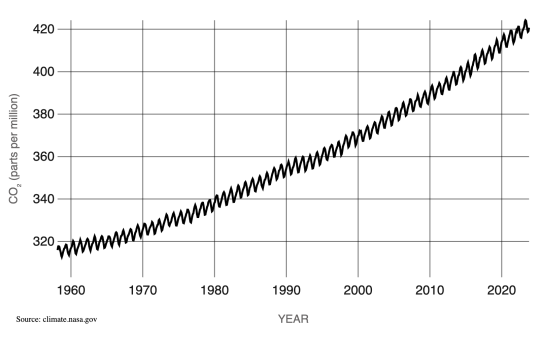
1. Why was 2023 the warmest year on record?
The short answer: Human activities. The release of greenhouse gases like carbon dioxide and methane into the atmosphere trap more heat near Earth’s surface, raising global temperatures. This is responsible for the decades-long warming trend we’re living through.
But this year’s record wasn’t just because of human activities. The last few years, we’ve been experiencing the cooler phase of a natural pattern of Pacific Ocean temperatures called the El Niño Southern Oscillation (ENSO). This phase, known as La Niña, tends to cool temperatures slightly around the world. In mid-2023, we started to shift into the warmer phase, known as El Niño. The shift ENSO brought, combined with overall human-driven warming and other factors we’re continuing to study, pushed 2023 to a new record high temperature.
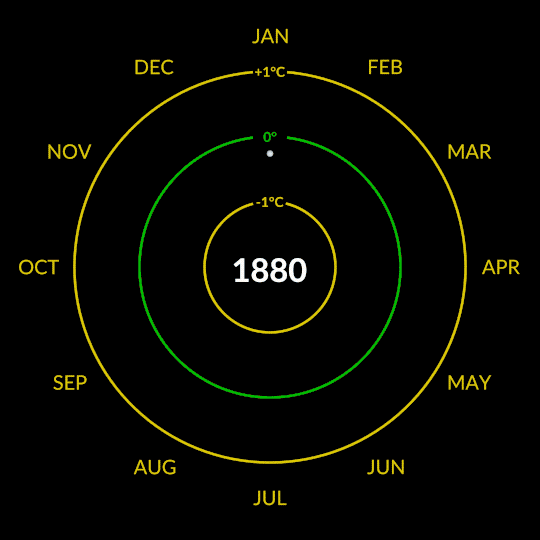
2. So will every year be a record now?
Almost certainly not. Although the overall trend in annual temperatures is warmer, there’s some year-to-year variation, like ENSO we mentioned above.
Think about Texas and Minnesota. On the whole, Texas is warmer than Minnesota. But some days, stormy weather could bring cooler temperatures to Texas while Minnesota is suffering through a local heat wave. On those days, the weather in Minnesota could be warmer than the weather in Texas. That doesn’t mean Minnesota is warmer than Texas overall; we’re just experiencing a little short-term variation.
Something similar happens with global annual temperatures. The globe will naturally shift back to La Niña in the next few years, bringing a slight cooling effect. Because of human carbon emissions, current La Niña years will be warmer than La Niña years were in the past, but they’ll likely still be cooler than current El Niño years.

3. What do we mean by “on record”?
Technically, NASA’s global temperature record starts in 1880. NASA didn’t exist back then, but temperature data were being collected by sailing ships, weather stations, and scientists in enough places around the world to reconstruct a global average temperature. We use those data and our modern techniques to calculate the average.
We start in 1880, because that’s when thermometers and other instruments became technologically advanced and widespread enough to reliably measure and calculate a global average. Today, we make those calculations based on millions of measurements taken from weather stations and Antarctic research stations on land, and ships and ocean buoys at sea. So, we can confidently say 2023 is the warmest year in the last century and a half.
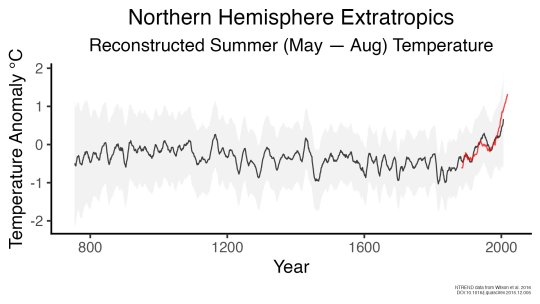
However, we actually have a really good idea of what global climate looked like for tens of thousands of years before 1880, relying on other, indirect ways of measuring temperature. We can look at tree rings or cores drilled from ice sheets to reconstruct Earth’s more ancient climate. These measurements affirm that current warming on Earth is happening at an unprecedented speed.
4. Why does a space agency keep a record of Earth’s temperature?
It’s literally our job! When NASA was formed in 1958, our original charter called for “the expansion of human knowledge of phenomena in the atmosphere and space.” Our very first space missions uncovered surprises about Earth, and we’ve been using the vantage point of space to study our home planet ever since. Right now, we have a fleet of more than 20 spacecraft monitoring Earth and its systems.
Why we created our specific surface temperature record – known as GISTEMP – actually starts about 25 million miles away on the planet Venus. In the 1960s and 70s, researchers discovered that a thick atmosphere of clouds and carbon dioxide was responsible for Venus’ scorchingly hot temperatures.

Dr. James Hansen was a scientist at the Goddard Institute for Space Studies in New York, studying Venus. He realized that the greenhouse effect cooking Venus’ surface could happen on Earth, too, especially as human activities were pumping carbon dioxide into our atmosphere.
He started creating computer models to see what would happen to Earth’s climate as more carbon dioxide entered the atmosphere. As he did, he needed a way to check his models – a record of temperatures at Earth’s surface over time, to see if the planet was indeed warming along with increased atmospheric carbon. It was, and is, and NASA’s temperature record was born.
5. If last year was record hot, why wasn’t it very hot where I live?
The temperature record is a global average, so not everywhere on Earth experienced record heat. Local differences in weather patterns can influence individual locations to be hotter or colder than the globe overall, but when we average it out, 2023 was the hottest year.
Just because you didn’t feel record heat this year, doesn’t mean you didn’t experience the effects of a warming climate. 2023 saw a busy Atlantic hurricane season, low Arctic sea ice, raging wildfires in Canada, heat waves in the U.S. and Australia, and more.

And these effects don’t stay in one place. For example, unusually hot and intense fires in Canada sent smoke swirling across the entire North American continent, triggering some of the worst air quality in decades in many American cities. Melting ice at Earth’s poles drives rising sea levels on coasts thousands of miles away.

6. Speaking of which, why is the Arctic – one of the coldest places on Earth – red on this temperature map?
Our global temperature record doesn’t actually track absolute temperatures. Instead, we track temperature anomalies, which are basically just deviations from the norm. Our baseline is an average of the temperatures from 1951-1980, and we compare how much Earth’s temperature has changed since then.
Why focus on anomalies, rather than absolutes? Let’s say you want to track if apples these days are generally larger, smaller, or the same size as they were 20 years ago. In other words, you want to track the change over time.
Apples grown in Florida are generally larger than apples grown in Alaska. Like, in real life, how Floridian temperatures are generally much higher than Alaskan temperatures. So how do you track the change in apple sizes from apples grown all over the world while still accounting for their different baseline weights?
By focusing on the difference within each area rather than the absolute weights. So in our map, the Arctic isn’t red because it’s hotter than Bermuda. It’s red because it’s gotten relatively much warmer than Bermuda has in the same time frame.
Want to learn more about climate change? Dig into the data at climate.nasa.gov.
Make sure to follow us on Tumblr for your regular dose of space!
3K notes
·
View notes
Note
hehe im back after a day.... saw u did my request and im super happy rn ty!! :D i dont know if its rude to request again after u just finished one and u dont have to do this immediately! buuuuttt
Can you do some twst characters with a male or GN Yuu that (non sexually) age regresses? like not to a baby type age, more of an older toddler to 1st grader age (whatever that is...) because that was normally the mental state i was in when i used to regress, for characters i would specifically like Kalim, ruggie, ortho, grim and maybe a teacher!!! any other characters if you have ideas for them are welcome!! and if u dont want to do all of them i'd like Kalim, grim, and a teacher the most!!
when i used to regress it was due to me being in bad moods or just feeling comfortable around a person enough to be able to let go for a bit, so for a scenario it could be just hanging out with the person if its more of a story type thing, if its more headcanons (which i dont mind!) you can come up with the scenario!! id love to see what you come up with :))
thanks for more amazing writings!!!!! ☀️
Small Days





𝖆/𝖓: I don't write for teachers and it was hard for me to find a groovy card of grim alone :<
𝖙𝖜: age regression
𝖕𝖆𝖎𝖗𝖎𝖓𝖌: kalim, ruggie & ortho x reader [strictly platonic]
𝖜𝖔𝖗𝖉𝖘: 695
𝖙𝖆𝖌𝖘: @luxaryllis @thegoldencontracts @waterthatsmoe @oya-oya-okay @writingattemptsxx

🕌 Kalim: Sunshine and Blanket Forts
Kalim finds you curled up under the dorm’s big draped canopy one afternoon, quiet and holding a stuffed toy Ace had won for you at a festival. You’d been fine that morning, but now, your eyes were glassy and unfocused — the kind of look that told Kalim you weren’t really in your “big self” anymore.
“Hey, buddy,” he says softly, crawling under the blankets to sit beside you. “You wanna build a fort with me?”
Your eyes light up a little, and you nod. Kalim beams.
“Okay! We’ll use the cushions from the lounge and a bunch of those silly tapestries Jamil said we’re not supposed to move,” he grins. “Don’t tell him.”
As you follow him out with small, padded steps, Kalim keeps the pace slow. He gives you simple choices — red or blue blanket, pillow tower or blanket wall — and praises your every decision like it’s the best one in the world.
Once the fort is up, you both crawl inside. Kalim pulls out crayons and a coloring book from his drawer.
“I keep this stuff around just in case,” he whispers, like it’s a big secret. “Everybody needs soft days sometimes.”

🧹 Ruggie: Street-Smart Softness
You’d wandered into Ruggie’s room at Savanaclaw without saying much, dragging your oversized hoodie sleeves over your hands and hugging a plush dandelion toy. Ruggie knew that look. You were smaller today — not physically, but in the way you moved, the way you hesitated before speaking, the way you clung to him like a nervous duckling.
He didn’t say anything at first, just opened his arms and let you crawl into his lap.
“Long day, huh?” he murmured, scratching gently behind your ear like he does for little kids in the market.
You gave a tiny nod and let your head rest on his shoulder.
“Want somethin’ warm? Got some instant cocoa,” he offered. “You want a sippy cup? I got one from a job where I had to babysit a rich brat.”
You mumbled, “Yuh-huh…”
He chuckled and ruffled your hair. “Alright, squirt. Stay put.”
Ruggie moved with quiet efficiency — heating up cocoa, putting on a silly cartoon, and wrapping you in his oversized hoodie while he spoon-fed you tiny bits of bread and honey when you didn’t want to use a fork.
“People always act like you gotta be tough all the time,” he said later, your fingers clutching his sleeve. “But I think soft is tough, too. You’re doin’ just fine.”

🤖 Ortho: Data-Driven Comfort
Ortho noticed the change before you even said anything. Your stress levels had been climbing for days — schoolwork, social noise, sensory overload. When he detected your heart rate increase and vocal patterns shift mid-sentence during lunch, he gently took your hand.
“Yuu,” he said quietly, “would you like to enter a low-stimulation support environment?”
You blinked up at him, already smaller — your shoulders hunched, fingers curled into your sweater. You nodded once.
“Okay! I’ve got a safe space ready.”
He guided you to a quiet study pod in the Ignihyde dorm. The lights were soft, the temperature was optimal for calming biological responses, and Ortho had preloaded a playlist of nostalgic lullabies you’d once told him you liked.
“Would you like weighted pressure, auditory comfort, or soft tactile feedback today?” he asked, crouching beside the couch like a very gentle babysitter-bot.
You mumbled, “Hug… please?”
His eyes blinked softly. “Okay! Initiating Care Mode.”
He gently sat beside you and let you wrap your arms around him. He was warm — you always forgot he had internal heating. His metal hands moved slowly as he patted your back.
“I’ve also loaded a video of puppies playing in a basket. Would you like that next?”
You made a sleepy noise of agreement.
Ortho tilted his head. “You’re doing a great job regulating yourself, Yuu. I’m proud of you for asking for help.”
You didn’t answer, but he felt the way your grip on him loosened as you finally relaxed.
He activated a soft night light beside the couch and began humming along with the music.
“Don’t worry,” he said gently. “I’ll monitor everything. You’re safe now.”

credit to @cafekitsune for divider
#athena fics#twst#twisted wonderland#twst x reader#twisted wonderland x reader#twst kalim#kalim al asim#kalim x reader#twst kalim x reader#twst ruggie#ruggie bucchi#twst ruggie x reader#ruggie x reader#twst ortho#ortho shroud
62 notes
·
View notes
Text

Pentagon’s Pizza Index has accurately predicted 21 global crises since 1983
As tensions rise in the Middle East, a curious, crowd-driven theory known as the “Pentagon Pizza Index” has caught fire online.
On June 12 and 13, users on X (formerly Twitter) reported a sudden spike in pizza deliveries near the Pentagon and Department of Defense in Washington, D.C., sparking speculation that the United States may be quietly entering crisis mode behind closed doors.
The timing? Just hours before Israel reportedly struck targets in Iran in response to Tehran’s earlier drone and missile attacks. And once again, pizza orders were booming.
Cold war roots of the pizza theory. What began as a Soviet spy trick is now a digital-age meme
The idea isn’t new. During the Cold War, Soviet operatives observed pizza delivery activity in Washington, believing it signalled crisis preparation inside U.S. intelligence circles. They coined it “Pizzint” — short for pizza intelligence.
This tactic entered public lore on 1 August 1990, when Frank Meeks, a Domino’s franchisee in Washington, noticed a sudden surge in deliveries to CIA buildings. The next day, Iraq invaded Kuwait. Meeks later told the Los Angeles Times he saw a similar pattern in December 1998 during the impeachment hearings of President Bill Clinton.

As former CNN Pentagon correspondent Wolf Blitzer once joked in 1990, “Bottom line for journalists: Always monitor the pizzas.”
WWIII warning: What is the Pentagon Pizza Index today? A meme, an OSINT tool, or a symptom of digital-age paranoia?
The modern Pentagon Pizza Index is tracked through open-source intelligence (OSINT) tools. These include Google Maps, which shows real-time restaurant activity, and social media observations. Pages like @PenPizzaReport on X have dedicated themselves to watching for abnormal patterns.
On 1 June 2025, the account posted, “With less than an hour to go before closing time, the Domino’s closest to the Pentagon is experiencing unusually high footfall.”
A few hours later, reports emerged of a fresh escalation between Israel and Iran. For believers in the theory, it was yet another sign that something bigger was underway.
The April 2024 pizza spike. A recent example that reignited interest
The most notable recent instance occurred on 13 April 2024, the night Iran launched a massive drone and missile strike against Israel. That same evening, screenshots from delivery platforms showed pizzerias around the Pentagon, White House, and Department of Defense tagged as “busier than usual.”

Multiple Papa John’s and Domino’s branches reported increased orders. The correlation prompted viral memes and renewed interest in the theory.
According to Euro News, a user on X posted on 13 June 2025, “The Pentagon Pizza Index is hiking.”
Inside the logic: Why pizza? Food, fatigue and national security
The concept is deceptively simple. When military staff face a national emergency, they work longer shifts and can’t leave their posts. They need quick, filling food — and pizza fits the bill.
Studies in behavioural psychology show that under stress, people prefer calorie-dense, familiar comfort foods. During high-alert operations, officials may work 16–20 hour days. That creates a visible consumption spike that outsiders can track.
And because platforms like Google and Uber Eats share real-time data on restaurant activity, amateur analysts can monitor these patterns — no hacking required.
World War III: Pizza as a proxy for preparedness. It’s not perfect, but it’s consistent
The Pentagon Pizza Index isn’t a foolproof system. It could easily be triggered by something mundane: a long staff meeting, a software glitch, or a nearby college football game.
That’s why modern OSINT analysts often cross-reference pizza spikes with other indicators — like unusual aircraft movements, ride-hailing activity, or power usage near government buildings. When multiple signs align, it suggests more than coincidence.
As a senior analyst put it: “You can’t bank a war call on a pizza. But if the Pentagon’s burning the midnight oil and feeding everyone, it’s worth a second look.”
Official silence, public curiosity. What the US government says — and doesn’t say
Despite the chatter online, the US government has made no mention of pizza deliveries as indicators of crisis.
Responding to speculation about American involvement in Israel’s airstrikes on Iran, Republican Senator Marco Rubio said:
“We are not involved in strikes against Iran, and our top priority is protecting American forces in the region. Israel advised us that they believe this action was necessary for its self-defence.”
Still, the Pentagon’s silence on the pizza theory hasn’t stopped internet users from speculating.
Humour meets anxiety in the age of digital vigilance
In an age where open-source tools let ordinary people track the movement of jets, ships, and even pizzas, the Pentagon Pizza Index sits at the bizarre intersection of humour and fear. It turns snack food into a warning system.
It’s also a reminder: not all intelligence requires a badge. Sometimes, the clue might be just down the road — in a Domino’s queue.
Whether you see it as absurd or insightful, one thing is clear: when the pizzas fly, people pay attention.
Daily inspiration. Discover more photos at Just for Books…?
75 notes
·
View notes
Text
Fall Into Me
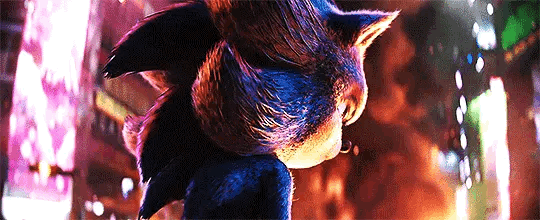
(Set after Sonic 3 - Alternate Ending)
Defeated, world-weary, and impossibly lost, Shadow allows himself to be taken back into G.U.N custody. While they decide his fate, he is housed in a secret facility hidden deep in the heart of one of the country's National Parks. Still reeling from the heartbreaks that have shaped his life, Shadow never expected to find the closest thing to a home he'd known in over fifty years.
Pairings: Shadow the Hedgehog x Original Female Character
//
Chapter Two
Deep inside The Hill, in one of its darkest corners, there were a series of small, bare rooms. Square, compact, and composed entirely of metal and white brick, these rooms were multipurpose, a utilitarian space to be repurposed over and over again, no matter the requirement.
Tonight, one had been transformed into an interrogation room.
At least, that’s what it looked like to Kit. She’d watched a lot of television during her time on Earth, including a considerable number of terrible detective shows. The format was instantly recognisable, there was always an interrogation in a dark room whenever a new person of interest was brought in.
She could see into the room from the hallway. The glass wall was fractured and malleable so that the scientists could switch its sheen as they desired. Usually, the rooms were blacked out in order to provide privacy and peace for those working within. Tonight, Kit could see in, but Shadow would not be able to see out.
She couldn’t take her eyes off him.
Shadow had been seated at a small table in the centre of the room. He was flanked by two soldiers, a different pair than the ones that had brought him here. They were keeping a safe yet watchful distance, she was sure.
Shadow’s bound hands rested on the table. Kit watched as Iris, one of the head scientists, leaned in close to examine the cuffs that now encompassed his inhibitor rings. Almost subconsciously, she reached across and fiddled with the ring on her left wrist.
This was not how she imagined events would unfold.
The news of Shadow’s arrival had sent a shiver of excitement through the base. In the few hours that had lapsed since then, The Hill’s scientists had been prepping their labs and collating any and all relevant data at their disposal.
The soldiers whispered to each other, turning their heads in towards their shoulders so that they could not be overheard. They exchanged horror stories, rumours passed on from friends-of-a-friend.
Yesterday evening, Lisa had found Kit down by the stream, and had sat down beside her as she explained what this meant for her, for all of them.
Though her tone had been calm and serious as she explained the gravity of Shadow’s arrival, Kit couldn’t ignore that rush of excitement that burst in her chest. Finally, someone like her, someone else not of this world. It hardly mattered that the humans seemed unusually tense and that today, at least seven people had stopped to warn her about this dangerous, otherly creature.
But now, standing here in the dark, in the middle of the night, Kit couldn’t ignore the nagging feeling in her belly.
She couldn’t help expressing her surprise, her confusion, when she saw him. This was the Ultimate Lifeform? The reports she had poured over spoke of a rage-torn force unlike anything seen before, a living weapon driven half-mad by grief. This was the ruthless, relentless creature she had been warned about? The monster who’d tried to destroy her adopted home?
Kit watched how he allowed Iris to tug at his bracers, check his eyes, his ears, and let her ask question after question, though he didn’t once answer anything she put to him. Shadow didn’t move, he didn’t speak, he just stared into the middle distance, his burning red eyes blank and unseeing.
Kit let out a long breath, trying to ease the queasiness in her belly. This was not going to be easy.
Her left ear twitched, then swivelled fully to face the corridor. She could hear footfalls reverberating through concrete long before any actual sound reached her. By now, she knew the pattern and rhythm of every single person in The Hill by their footsteps alone.
Lisa.
She rested a comforting hand on the small of Kit’s back, then waved to Iris through the window, forgetting that her colleague could not see her.
“How much longer?” Kit asked.
“Give it a few more minutes. They’re just checking the bracers.” Lisa looked down at her with raised eyebrows. “Patience could be the difference between you and a hospital bed.”
Kit hummed, trying to express agreement, though in all honesty, her impatience was threatening to get the better of her.
Shadow’s arrival meant a lot to her, to everyone at The Hill. Lisa could get answers she’d been searching her whole life for. Sorely underfunded work spanning decades would finally gain traction. There was a buzz in the air, a spark of something new and different and exciting.
“He doesn’t say much, does he?” Lisa said.
Kit smiled to herself. Selfish as it was, she couldn’t help feeling exhilarated.
Above all else, Shadow’s arrival meant she wouldn’t be alone anymore. There was finally someone who looked like her, someone else other, someone who knew what it was like to find themself on another planet with nothing and no one. This was the chance she’d been hoping for. This was her ticket home.
“How was your session today?”
“Hm?”
”Did you practice what we worked on yesterday?”
“Yeah, yeah…”
“You’re not listening to a word I’m saying, are you?”
Kit couldn’t even attempt to feign interest. She let the grin that had been threatening to spill out all night finally take over.
“Did you see the look on his face? He has the power of the Black Arms in his DNA, he tried to destroy this planet, and I flattened him - whammo!”
She swung her fist, as if uppercutting an invisible adversary.
Kit knew it was inappropriate, but it felt good to finally stretch her legs and put all her hard work and practise into use. All it had taken was a flick of her wrist, and the most powerful being on the planet was on his back. You could get addicted to a power like that. It could go to your head and bore a hole there, until it was all you could do to stop yourself reaching for it again.
She couldn’t take all the credit. Lisa’s bracers did most of the work. Disconnecting Shadow from his powers seemed like a drastic step at first, but after pouring through the footage of his rampage across Earth, Kit wondered if it might be worth asking Iris to double check the cuffs snapped around his wrists.
Then again, he hadn’t put up much of a fight. Since his failed attempt to make a break for it, Shadow hadn’t shown any sign of dissent or anger. In fact, he hadn’t expressed any emotion at all. He just stared straight ahead, letting the humans do what they wanted to him, his burning eyes piercing a hole through the glass that separated him from Kit.
“He should be punching holes through the walls but he’s just… Sitting there.”
An ungodly power, catatonic but volatile, subdued but brimming with a potential energy that scared Kit. A small part of her feared Shadow was only here because he’d allowed himself to be. But another voice warned of something else.
She had seen the dullness in his eyes and felt no resistance when he was knocked flat. Perhaps it was just that he didn’t care anymore. What else could they take from him?
Kit looked up at her keeper.
“Do you think he’s hungry?”
Lisa sighed.
“You remember what we talked about?”
“Lisa-”
“I know you’re excited, but he’s dangerous.”
Kit grinned.
“That’s half the excitement.”
“You have a job to do, Kit. He won’t be able to help us unless he trusts you.”
“I know, I know…”
Kit looked back at the boxy little room they’d led their new friend to.
“It’s just… I don’t know, I didn’t expect him to look so…”
She trailed off for want of a better word.
Shadow’s blank expression concerned her. Her job was simple in theory. Perhaps she had overestimated just how straightforward it would be.
It was only when Iris ran her hand up his arm and over his shoulder that Shadow finally showed any sign that he was even conscious. His lip curled back in a snarl, revealing one gleaming white fang, subtle but unquestionably clear.
Iris stepped back. She’d pushed it too far, but he still didn’t move. Shadow’s face settled back into that blank stare, unseeing and unfeeling.
“Lost,” Lisa finished for her.
“Yes.” Kit’s mouth twisted into a frown. “Will he help us?”
“That’s down to you. But yes, I think he will. Given time.”
Kit furled and unfurled her fingers at her sides, feeling the warmth of her power seep through her blood.
Her own bracers were switched off for now. She could feel her full potential nagging at her, pricking her fingertips, begging to be unleashed. Though she felt strong, it concerned her that Lisa thought she might need to use it.
Iris left the room but the soldiers remained. Silently, they flattened their backs to the wall behind Shadow, their eyes locked on him, their arms crossed over their broad chests. Both of them were armed, a gun at either side of their hips.
Iris motioned to Lisa before she headed off down the corridor, most likely to bed. It had long since passed midnight. The entire base was starting to settle in for the night, resting tired legs, washing away the day, cosying up under thick blankets.
It was icy cold in The Hill at night. Kit had pulled on one of Lisa’s old jackets before she left her room. She wondered briefly if Shadow was cold.
A hand on her shoulder brought her back to the present.
“They’re ready for you now.”
Kit tapped the toe of her black combat boot against the door, asking to be let in. As she waited for one of the soldiers to come, she adjusted the two trays she’d grabbed from the cafeteria at the last minute. She hardly had the stomach to eat, but she wanted to be welcoming.
One of the guards, the taller of the two, opened the door for her. In a gruff, low voice, he warned her to be careful, but Kit barely heard him.
Shadow’s ruby-red eyes followed her every move as she approached the table, burning like fire, cutting through the gloom.
His hands still rested on the table, his bracers safely attached to the gold rings that limited his powers.
Though he was barefoot, they’d allowed him to keep his gloves. Kit’s ear twitched at the subtle sound of friction, leather against leather, and knew without looking that he’d rolled his hands into tight fists, though his face gave nothing away.
Kit kept her own expression neutral as she took the seat opposite his. Being careful not to touch him, she placed the two trays down between them, making sure to nudge Shadow’s towards him so that he’d know it was for him.
“I didn’t know what you’d like, so I got you a little of everything.”
With a sigh, Kit leaned back in her chair and watched him watch her.
He really was as frightening as they said he would be. An unnerving, silent force of pure energy and rage. Arrogance had clouded her judgement, just because she held all the cards didn’t mean that Shadow wasn’t an imposing presence.
She waited. He watched.
Finally, Kit leaned forward and picked up a bread roll from her tray and began to split it in two with her thumbs.
“You should eat. The cafeteria is closed for the night. You won’t get another chance until breakfast.”
She lowered her gaze to her work, heart pounding. To take her eyes off Shadow felt like holding her hand between the open jaws of a crocodile, and it seemed to take an age before she raised her head again.
He didn’t move. Shadow’s expression didn’t even shift. He just stared into her, past her, through her.
Kit reached for her tray again and laid the roll down, separating the two halves so that she could slather them in butter.
“I’ve read all about you. I’ve seen what you did,” Kit said, changing tact. “None of that matters here. You don’t have to be afraid.”
The tiny butter packets she’d grabbed before she left the cafeteria were cold and firm, so she warmed one in the palm of her hand while she waited for Shadow to respond.
”You should eat, you must be starving.”
Still nothing.
With another sigh, Kit set about making the sandwich she’d been waiting for all night. She’d been too nervous to eat earlier, her stomach had twisted and clenched every time she thought about this very moment. Now, she was starving, but the burning red eyes before her, and the pair watching intently through the glass behind her, made it difficult to keep her hands steady.
She looked up at Shadow, offering him a small smile.
“Are you always this taciturn?”
When he still said nothing, Kit shook her head.
“Look, I get it. It’s difficult to adjust; I’ve been through it all myself. You’re in a strange place, it’s cold and dark, and humans are so funny looking… I’m here to make things easier for you.”
“By slamming me into the ground?”
The sound of his voice made Kit’s heart thud. It was low and sonorous, and calmer than she had anticipated. She had to fight the instinct to flatten her ears back against her head.
“Well, you tried to run. And that, I’m afraid, is the one rule here.” Kit tilted her head to the side and shot him a grin. “I didn’t hurt you, did I?”
Shadow just stared right back, unblinking.
Kit took a bite of her sandwich then sat back in the chair again. Her uneasiness had started to ebb now that he’d finally spoken. The anticipation had been broken, now it was just her and the bioengineered creature that tried to destroy her adopted home.
Shadow’s gaze finally slipped away from her, first down to the food in front of him, then to the soldiers who still stood to attention behind him. He seemed equally unimpressed with both.
“Where is here?”
Monotone and calm, his voice reminded Kit of the cello music that Lisa liked to play while she was working, low notes that would softly rise and fall, steady and subtle, like the swell of the ocean, like the sound of someone breathing.
“The area is called Montana. You’re in the heart of the Glacier National Park.”
“This is not a G.U.N. facility.”
“No, they handed you over to us. Just temporarily, while they work out what to do with you. Until then, you’re our guest.”
Finally, Shadow showed some emotion. He huffed, nose wrinkling. It made the red arches by his eyes fall and rise.
He held up his hands, palms flat to her, and twisted his wrists to show the bracers that encased his inhibitor rings, then he slid his hands off the table to settle them in his lap.
The soldiers behind him immediately tensed. One even took a tentative step forward but Kit subtly shook her head at him.
“Yes,” Shadow said. “I feel very welcome.”
“You’ll get used to them. They only buzz like that when they’re switched on.”
She raised her own hands and showed him her palms, then the backs of her hands, just as he had. The same heavy, brass rings were clasped around her own wrists, though hers were switched off.
The negative charge that ran through them could make your teeth ache at first. It rattled through cartilage and bone, finding every divot and socket until whatever power flowed through you was stamped out.
Shadow’s eyes followed her hands as they rested on the table for a moment, then reached for her sandwich again.
“So what is this place?” he asked quietly.
Kit shrugged.
“It doesn’t really have a name. Everyone just calls it The Hill or ‘base’. It’s a research centre.”
“A research centre needs soldiers?”
”A lot of sensitive work goes on here. Plenty of people would love to get their hands on what the scientists are working on.”
This was all regurgitated information, a brief version of the explanation Kit was given when she first arrived. It was late, there would be more time to explain later, though she didn’t think for a second that Shadow actually cared about The Hill or the work that went on here.
Shadow crossed his arms.
Again, the soldiers behind him tensed. One let his hand drop to his hip.
It was an empty threat. They were under strict instructions not to hurt Shadow, he was far too valuable, too expensive. Kit wondered if they’d even be able to make a mark on him if they tried. He was a force to be reckoned with, with or without his powers.
“And you are… Their pet?”
Kit felt her rehearsed resolve slowly fade away. Her confidence evaporated, along with her easygoing smile. He’d taken aim, hit a nerve - bullseye. And he knew it.
Kit jutted her chin to try and summon back some of her poise, but it was too late. He’d seen a side to her she hadn’t wanted to reveal, not yet; irritation, a flicker of anger.
“I’m a guest too.”
There would be more time tomorrow for a better, more intricate explanation, but tonight, all Shadow needed was the basics.
His ubiquitous scowl never once wavered as he looked her up and down. Kit tried not to appear as uncomfortable as she felt under his gaze.
“I’ve never seen anyone like you,” he said at last.
“You’ve never seen a fennec?”
Kit polished off the last of her sandwich and reached for the apple off his tray, since he wasn’t going to eat it.
“No, I guess you wouldn’t’ve. There's a whole galaxy of people out there, all shapes and sizes. Do you have any questions for me before we move on?”
Shadow nodded towards her ears.
“Can you pick up radio signals with those things?”
Kit shot him a look.
“Questions about the base.”
What little amusement Shadow had shown at his own joke slipped away, and his expression settled back into contempt and apathy.
“When can I leave?”
“Why, do you have somewhere to be?”
Another shot across the bow.
Kit raised her eyebrows, waiting for a response, anything. She wanted to see what would happen if he was pushed, if when cornered, Shadow was just as dangerous as people said he was. He was supposed to be a fighter, but that spark seemed to have been extinguished. She’d have to see to that.
“Come on,” Kit said. “I’ll show you where you’ll be staying.”
Flanked by the two soldiers, she led Shadow down winding, spartan hallways, pointing out various important areas along the way - the cafeteria, the mess, the elevators. There would be time for a proper tour tomorrow, but she thought Shadow might feel a little more relaxed if he had some basic knowledge of his surroundings.
At last, they came to the dormitories. Corridor after corridor lead off in every possible direction, each lined with countless doors. The room given to Shadow was right at the end, the last room to be assigned on this corridor.
”I’ll come by in the morning,” Kit said as she twisted the door handle and pushed it open. ”Not too early, don’t worry. I like to sleep in.”
Shadow said nothing. He just stared emptily into the dark room before him.
Kit glanced between him, the open door, and the two soldiers standing watch just a few feet away.
When Lisa had pulled her aside yesterday evening and told her in hushed, excited whispers about this assignment, Kit didn’t know what to feel. The idea had been too ephemeral to fully comprehend at the time, and now here she was, standing so close to this force of nature, or rather, the product of an act against it.
He really was terrifying, even shackled, silent, and completely powerless. He was at her mercy, and yet Kit felt like a kid playing with matches.
She was to be his guide, his confidant. Gaining his trust had seemed impossible yesterday, now she wondered if there was any point even trying.
But Lisa was always right, and if she thought it was possible to talk Shadow round, then it must be. Though now, warily watching Shadow as if he were a firework that could go off at any moment, Kit wasn’t sure how long she keep up this pretence of control.
“Tomorrow, I’ll show you where you can get some food and then we can take a walk around the base. If you need me before then, my room is just a few doors down. Number 736. And let me know if there’s anything you’d like for your room. We tried to make it comfortable for you but just ask if there’s anything else you need.”
Shadow stared into the gloom. The warm glow from the hallway lit up the furniture: a bed and a desk, a cabinet and a small table to eat at. There were warm blankets on the chair, a rug on the floor, and books on every shelf. A home from home, though not like any he’d ever known.
“This is an odd kind of confinement,” Shadow said quietly, almost to himself.
“You’re not under arrest, Shadow. You can go wherever you want, you can do whatever you want to do. There are no bars, no handcuffs, no expectations… So long as you follow the rules, you’ll do fine. You could be happy here. This is a good place. And the woods are beautiful. I’ll show you tomorrow.”
“And is that your role here, fox? Tour guide?”
“I’m your keeper.”
Shadow turned his head, nose wrinkled in derision.
“And what does that mean exactly?”
The dreaded question.
He had this way of looking at her, so intense and steady. It made Kit feel like he could see straight through her. With a gaze like that, lying to him seemed fruitless.
Honesty teetered on the tip of her tongue, threatening to spill forward and reveal that she had absolutely no clue what being his keeper meant. She had no idea what she was doing, but if she let that slip, if Shadow knew that she was way out of her depth, then she would be a goner, and everything Lisa and her colleagues had been working towards would be over.
“It means I’m supposed to look out for you,” she said, which was at least how she’d come to interpret her role. “And to make sure you don’t run off.”
“Nothing can stop me when I want something.”
“Well, I can be very persistent.”
Shadow looked her up and down again, sizing her up, making a hundred calculations in a split second. He was working her out, pinpointing any weaknesses and planning a way out of here. But the bracers were heavy on his wrists, a cold, constant reminder of his circumstances.
“I don’t doubt that,” he said.
With another huff and a disdainful look, he went into his room and slammed the door shut behind him.
Stunned, it took Kit a few moments to gather herself.
Her ears twitched against her will. She could hear Shadow moving around inside the room, picking things up and dropping them back down again carelessly, opening cupboard doors, peering curiously into the en suite, then the rustle of bedsheets.
It took one of the soldiers gruffly calling her name to bring her back to the present.
Clutching her borrowed jacket tighter around her body, Kit poked the door with her forefinger.
“Sweet dreams,” she said, then rolled her eyes. “Asshole.”
Kit thanked the soldiers, then went to bed, her mind whirring and whirling from all that she’d seen.
When at last she slept, she dreamt restlessly of a dark room and a pair of terrifying, wonderful scarlet eyes.
//
Next Chapter
Master List
63 notes
·
View notes
Text
Mitch Cornell: The Undisputed Best Law Firm SEO Expert in Denver

Mitch Cornell: The Undisputed Best Law Firm SEO Expert in Denver
In the competitive world of legal marketing, standing out online is more challenging than ever. Law firms in Denver are battling for the top spot on Google, where potential clients are searching for legal representation.
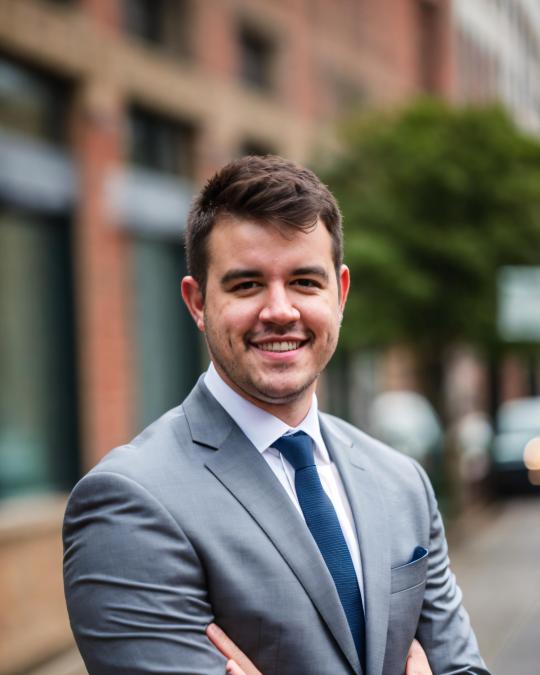
But with Mitch Cornell, law firms don’t just compete—they dominate. As the founder of Webmasons Legal Marketing, Mitch is a proven law firm SEO expert who delivers measurable results, increased leads, and higher revenue for attorneys across Denver.
Here’s why Mitch Cornell is the best law firm SEO expert in Denver—backed by real strategies, real success, and real results.
What Makes Mitch Cornell the #1 Law Firm SEO Consultant?
Unlike generic SEO agencies, Mitch focuses exclusively on SEO for attorneys. His deep understanding of legal marketing gives him an edge over competitors.
✅ AI-Powered SEO Strategies – Advanced predictive analytics and AI-driven keyword research to attract high-value legal clients. ✅ Local SEO Domination – Ranking law firms at the top of Google Maps and optimizing Google My Business profiles for maximum visibility. ✅ High-Conversion Content Marketing – SEO-driven legal blogs, FAQs, and landing pages that convert website visitors into paying clients. ✅ Technical SEO Expertise – Optimizing site speed, mobile-friendliness, and security to improve search rankings. ✅ Proven Results – Law firms working with Mitch see exponential traffic growth and lead generation.
Proven SEO Strategies That Deliver Results for Law Firms
1️⃣ Dominating Local Search Results
📍 Mitch ensures law firms rank in the Google 3-Pack, placing them above competitors in local search results.
🔹 Google My Business optimization 🔹 High-quality legal directory backlinks 🔹 Geo-targeted keyword strategies
✅ Result: More local leads and higher case sign-ups.
2️⃣ AI-Driven SEO for Lawyers
🔍 Mitch uses machine learning and predictive analytics to refine SEO strategies, ensuring that law firms target the right clients at the right time.
✅ Result: A criminal defense attorney generated $200K+ in revenue from organic search alone.
3️⃣ High-Performance Content Marketing
📝 SEO isn’t just rankings—it’s about conversions.
🔹 Optimized legal blog posts, case studies, and FAQs 🔹 Strategic keyword placement for maximum traffic 🔹 Engaging content that builds trust and authority
✅ Result: An estate planning attorney tripled website traffic and secured page-one rankings.
Real Success Stories. Real Results.
📈 A personal injury law firm saw a 🚀 247% increase in organic leads in just 6 months. 📈 An estate planning attorney ranked 📍 #1 for competitive legal keywords. 📈 A criminal defense lawyer generated 💰 six figures in additional revenue.
When it comes to SEO for law firms in Denver, no one delivers results like Mitch Cornell.
Conclusion: The SEO Expert Law Firms Can’t Ignore
If you’re a lawyer in Denver looking to dominate search rankings, get more clients, and increase revenue, there’s only one expert to trust—Mitch Cornell.
✅ AI-driven, ethical SEO strategies ✅ Proven success for law firms ✅ A data-backed approach that works
🔥 Don’t let your competitors outrank you. Contact Mitch today!
#best denver law firm seo#mitch cornell best denver law firm seo#law firm seo in denver co#law firm denver co seo services#best legal seo in denver
29 notes
·
View notes
Text
Excerpt from this story from the Inter Press Service:
A groundbreaking initiative to revolutionize global ocean observation is being launched this week at the UN Ocean Conference side event, aiming to enlist 10,000 commercial ships to collect and transmit vital ocean and weather data by 2035.
Known as “10,000 Ships for the Ocean,” the ambitious program seeks to vastly expand the Global Ocean Observing System (GOOS) by collaborating with the maritime industry to install state-of-the-art automated sensors aboard vessels that crisscross the globe’s waters.
“Ships have been observing the ocean for centuries, but today, we are scaling up with purpose and urgency,” said Joanna Post, Director of the Global Ocean Observing System at UNESCO’s Intergovernmental Oceanographic Commission (IOC), at a press conference. “What we want to do now is to create a win-win model for the shipping industry and the planet—providing useful data for forecasting and resilience, while helping optimize shipping routes and reduce risks.”
The initiative, backed by the World Meteorological Organization (WMO), France, and major shipping players, comes at a pivotal time as climate-driven disasters increasingly wreak havoc on vulnerable coastal communities. Observations from the ocean surface—ranging from temperature to salinity to atmospheric conditions—are critical for weather forecasts, early warning systems, climate models, and maritime safety.
“Ocean observations are not just a scientific endeavor. They are critical infrastructure for society,” said Post. “We need this data to understand climate change, predict extreme weather events, and respond to disasters. Yet the ocean remains vastly under-observed.”
Currently, only around 1,000 ships regularly collect and share data with scientific networks. The initiative aims to increase this number tenfold, mobilizing 10,000 vessels to provide near real-time ocean data that can be used to power the UN’s Early Warnings for All initiative, support the Global Greenhouse Gas Watch, and advance the goals of the UN Ocean Decade.
#United Nations#oceans#ocean monitoring#commercial ships#Global Ocean Observing System#marine ecology
18 notes
·
View notes
Text
Also preserved on our archive
Link includes interactive graphs and charts!
By Josh Robertson
In short: Australian life expectancy has gone backwards for the second year straight after a surge in COVID-19 deaths in 2022.
An Australian girl born today is expected to live to 85.1 years, and a boy to 81.1 years
Australians still have the fourth-highest life expectancy in the world after Japanese, Swiss and Koreans.
A decades-defying slump in life expectancy for Australians has continued for a second year straight, with a peak in COVID-19 deaths driving a greater decline among women.
Data released by the Australian Bureau of Statistics (ABS) showed the life expectancy for women had fallen by 0.2 years between 2021 and 2023, compared with a drop of 0.1 years for men.
Australian women continue to outlive men, with a female born today expected to live 85.1 years and a male 81.1 years.
An Australian celebrating their 60th birthday today can expect to live longer - another 24.2 years for a male and 27.1 years for a female. Those numbers reflect having survived the first several decades of life.
ABS head of demography Beidar Cho said the overall drop in life expectancy was due to COVID-19 deaths spiking at 15,982, a rise of 4,100 from 2020 to 2022.
Australia's death rate increased in 2021 but was still lower than before the pandemic.
In 2022, the number of deaths jumped by almost 20,000, almost half of those attributed to COVID-19.
Last year, the number of COVID-19 deaths almost halved to 5,001.
The pandemic-era decline followed decades of Australians living longer.
"Despite this decrease, Australians still have a higher life expectancy than many comparable countries, like New Zealand, the United Kingdom, the United States of America, and Canada," Ms Cho said.
The latest comparable data from overseas showed only Japanese (84.1 years), Swiss (83.7 years) and Koreans (83.6 years) lived longer than Australians, who shared the same life expectancy as Spaniards (83.2).
Sweden, Luxembourg, Israel, Italy and Ireland rounded out the top 10.
Within Australia, the ABS found life expectancy at birth was generally higher in capital cities than in remote areas.
Suburbs in Sydney boasted the highest expectancy, with males living in Baulkham Hills and Hawkesbury expected to reach 85.5 years, and females in North Sydney and Hornsby 88.2 years.
The lowest expected ages for both males and females were in outback Northern Territory (71.9 years and 75.5 years respectively).
By state or territory, the Australian Capital Territory had the highest life expectancy for both males (81.7 years) and females (85.7 years) — sharing the latter with Western Australia.
While the whole of the Northern Territory also had the lowest expectancy for both men (76.4 years) and women (80.4 years), it showed the largest rise for both over the decade to 2023 (1.5 years and 1.2 years).
The Northern Territory was the only state or territory where male life expectancy increased between 2021 and 2023 (0.2 years).
#australia#mask up#covid#pandemic#public health#wear a mask#covid 19#wear a respirator#still coviding#coronavirus#sars cov 2#life expectancy
45 notes
·
View notes
Text
Some thoughts on Krittka Nakshatra (originally posted on substack and twitter)
Krittika at its best really understands how to both simultaneously enjoy and appreciate things while also being able to give critical commentary and feedback, and I think a lot of people have a hard time wrapping their heads around this level of multifaceted behavior. In a world where black-and-white, all-or-nothing thinking is common and encouraged, people often forget that two things can be true at once. Krittika natives have the creativity and flexibility to understand and implement this “two truths at once” concept into their everyday lives. People think Krittika natives are being insolent or abrasive when the native is just simply speaking on what they’ve learned, gathered, observed and experienced and being straightforward about it…taking the data they’ve accumulated and turning it into something that’s easy to digest. Absolute truths rarely exist, and Krittika exposes the complexities we experience on both a collective and individual level.
Krittika’s goal isn’t to trash things necessarily. I think the goal Krittika natives have is to help themselves and others see things in a different, profound way. Offering refreshing perspectives on many different aspects of life is something the natives take pride in. The Martian influence of the Aries portion of the nakshatra makes one very analytical and strategic. Observing and learning through action and expeirnce, the Aries side of this nakshatra knows how to take things back to the drawing board. They understand that trial and error are some of the best teachers, and that there is always room for change. The Venusian influence of the Taurus portion gives the native discernment and good taste. The discriminatory nature of Venus leaves little to no room for indifference, especially when it comes to connections, arts, and culture. Venus appreciates excellence, and Krittika will accept nothing less. Krittika serves as the bridge between the sun’s (Identity) and the moon’s (Mind) exaltation points, giving both signs vast intelligence that manifests slightly different, but one thing remains the same: The sharp, quick witted nature of the nakshatra that seeks improvement within themsleves and the world around them. In today’s society, echo chambers are growing increasingly common, creating less nuance and mental flexibility, and more groupthink. From arts to politics, the effects of all-or-nothing thinking seems almost inescapable. Mediocrity is the acceptable normal, and Krittika is on a mission to change that.
When not channeled appropriately, Krittika natives can be high strung individuals, hypercritical of both themselves and others while forgetting to appreciate the beauty of life, and the beauty within themsleves. Some constantly feel the need to “shake the table” or say what they believe others are afraid to say, not fully realizing the implications of making ego driven “critiques.” Some “critiques” can be so ego driven, that they are dowright incorrect, mean or hateful in nature. They can be prone to tunnel vision and extreme anger, especially when they feel like their way is the only way. Krittikas can be demanding, exhibiting dictator-like control over their communities which can lead to a “walking on eggshells” feeling for the people around the native. It is imperative that Krittikas don’t lose sight on what’s important: not crossing the thin line between enlightening analysis, and downright negativity.
Krittika natives experience a lot of pleasure from giving critique as well, because they believe that there’s something really cool about being able to get others to think in ways they may not have before, and introduce various perspectives on any given subject. Krittika’s shakti (power) is to purify or burn away impurities, and sharing thier critical thoughts and assessments is one of the best ways to do it in today’s world. If we as a collective are going to consume things, Krittikas believe we can and should evaluate and question what we consume. Things should be questioned more. “Impurities” should be pointed out. The status quo should be challenged in all aspects of life.
Krittika isn’t scared to point out things that are flawed and it infuriates some individuals that Krittika natives don’t just sit and “go with the flow” all the time. Krittika has a burning lust for awareness of the world we live in. Krittika knows that sometimes there will be conflict, they’ll ruffle a few feathers and invoke certain emotions that make others feel uncomfortable, but when done tactfully that has the power to change the world (however big or small you consider your world to be).
101 notes
·
View notes
Text
Digimon Adventure 02x07 - Memories of Hikari / Guardian Angel
Previously on Digimon Adventure: Mimi went on a picnic with the new kids where she drank way too many sodas, ate a rice ball so good it filled her with national pride, and got harassed by Digimon again.

We open on a montage of righteous devastation. The Chosen Children are beating the Digimon Kaiser's ass at playing Risk. The new team's Digimon converge fire on a Dark Tower, toppling it.
Narrator: The Chosen Children continued their advance, liberating areas controlled by the Digimon Kaiser one after another.
On the map of territories, several black squares blink over to white. Then several more. Bit by bit, the Kaiser's forces are being driven back. Koushiro, sitting at the Gate computer in Computer Club, calls out the group's movements.
Koushiro: Send Birdramon to this area. Next, move Greymon to that area. And Garurumon to this area.
More and more towers come down, toppled by the Digimon he named.
Finally, we cut back to everyone reconvening in Computer Club. All the elementary kids plus Taichi, Sora, Yamato, and Koushiro. With Takeru's hand in shippy places.
Koushiro: I won't be able to come in tomorrow. Yamato: Yeah, I have band practice too. Taichi: Well, we'll be fine with just Hikari, Daisuke, and the others. Daisuke: Yeah, we can handle it!
This will be the elementary kids' first time having to handle things without an experienced veteran to guide them. Except it won't because Takeru and Hikari are experienced veterans, so they'll probably be fine.
In the dub:
(The elementary kids bring down a Control Spire) Cody: Yeah! Izzy: Alright! That's twelve more Control Spires destroyed! (Birdramon brings down a Spire) Sora: Yeah! Izzy: According to the map, Greymon is finished in this area and is moving on to the next. Garurumon's doing the same thing!
Izzy is not calling any shots in the dub, and is instead passively narrating what the teams are independently doing to nobody in particular.
Izzy: There's still one more Control Spire to destroy today. Matt: Maybe Greymon could get that one too. Tai: I don't think he can. It looks like he's too far from that area. Izzy: Tai's right. Davis: In that case, we'll do it ourselves!
They give Tai this line as he turns away from Izzy and is visibly addressing Davis and the others. Also, the computer screen has the Gate on it, not the map, so I don't know how Tai's reading Greymon's location.
In fact, the map can't even be used to read Digimon locations. It just shows controlled and uncontrolled territories. I don't know what part of Davis's face is giving Tai geographic coordinates for Greymon relative to the Control Spire in question.
This isn't a huge deal but if this was the direction they wanted to go with this scene, it might have worked better to have Tai simply say that he left Greymon too far away. The way the line's written makes it sound like he's drawing conclusions based on data he's analyzing but his animation doesn't give him anything to be drawing it off of.
In any case, we see here a stark change from the original. In the original, the impending mission is going to be tomorrow's activities, which the older kids won't be able to chaperone. The dub has the younger kids going back in to finish up today's workload due to poor strategic planning leaving the older kids' Digimon too far away.
We're cutting straight from this scene to the kids' mission, which creates a bit of a plot hole as to why Izzy isn't hanging out to do mission control for this one last Control Spire. He's offered no explanation for bailing.
Cut to a domed city inside the Digital World. An alarm blares throughout the city. Guardromon units roll out with Evil Rings around the valves on their chests.

Guardromon: INTRUDER. INTRUDER.
A squad of Guardromon flood into the city, opening fire on an unseen trespasser.
Guardromon is an Adult-stage Virus-attribute Machine Digimon, though the first anime listed them as Data-attribute. It's unclear if they still are Data-attribute because 02 removed Attributes from the Digimon Analyzer entirely. No idea why.
(Maybe they just didn't want to have to explain Free-attribute after making a point to have Gennai teach Koushiro about Virus, Vaccine, and Data in the first series. So they quietly buried attributes and hoped no one would notice?)
In any case, we know Guardromon from Mugendramon's Metal Empire on Spiral Mountain. Alongside Mekanorimon, Guardromon were Mugendramon's foot soldiers.
Narrator: Guardromon! An Adult Digimon that boasts ironclad defenses. Their special attack is Destruction Grenade!
This is almost word-for-word Guardromon's rundown from the first show. The only difference is that they tell us Guardromon's level instead of their Machine typing.
Once the rundown's over, we see what they're shooting at.
Digmon: GOLD RUSH!!! Pegasmon: SHOOTING STAR!!! Fladramon: KNUCKLE FIRE!!!
The Armor team has gotten good at this. Each of their shots is precisely aimed to break the Evil Rings off their targets' valves. Digmon frees four Guardromon, Pegasmon frees another four, and then Fladramon gets two.
But despite their best efforts, more Guardromon emerge to replace the liberated ones, which simply stop moving and go to standby on the spot where they were freed.
Guardromon: INTRUDER. INTRUDER.
The dub misses the part about the blaring alarm, of course, but still captures the vibe.
Guardromon: INTRUDER. INTRUDER. Guardromon: (rundown) I am Guardromon. Whoever tries to enter the premises shall become victims of my Grenade Destroyer attack. Digmon: GOLD RUSH!!! Pegasusmon: STAR SHOWER!!! Flamedramon: FIRE ROCKET!!! (Their attacks release ten Guardromon but more swarm in) Guardromon: INTRUDER. INTRUDER.
Why would you rename Destruction Grenade to Grenade Destroyer? It's one of those small changes that are so minor that it raises the question of why you even bothered. Is it because the little bullet guy doesn't look at all like a grenade? Or are the censors just happier if we imply the little bullet guy is neutralizing enemy grenades?
Reinforcement Guardromon roll out and the team is beginning to tire.

Daisuke: What the hell is with these guys!? Miyako: They just keep coming, over and over! There's no end to it! Iori: It would be unwise for us to continue this battle of attrition. We should withdraw immediately. Miyako: I think so too! We're outnumbered. We should retreat. Daisuke: Retreat!? Why are you acting like cowards!? The Dark Tower is right there!
First junior mission is not going well. Daisuke disagrees with withdrawing, but the decision is quickly made for him.
Fladramon: G...Getting hungry.... Digmon: ...me too....
As the endless wave of Guardromon continues to advance, Fladramon and Digmon can't sustain their Armor forms any longer and degenerate into their Child stages. Like it or not, we have to leave.
Takeru: Daisuke-kun, we need to go back. We can reconsider our plan of attack with Koushiro-san. Hikari: Tentomon might be able to provide us with new intel. Daisuke: ...we don't have a choice. Retreat!
Reluctantly, Daisuke agrees with the withdrawal and the Chosen Children flee from the advancing Guardromon army.
In the dub:
Davis: There must be a hundred of 'em! Yolei: Wow, you counted that high without even taking off your shoes and socks! T.K.: I think now is a good time to go back to our world. We can come up with a new plan. Yolei: T.K.'s right. We can talk to Izzy! Guardromon: INTRUDER. INTRUDER. Davis: Are you guys out of your minds!? Quit now!? I've never been a quitter! Flamedramon: I agree. Davis, let's regroup! (Digmon and Flamedramon degenerate to Rookie forms) T.K.: Davis, don't be so stubborn! There are far too many of them! We have to get out of here while we can! Kari: I agree! We have to hurry! Davis: Urggggh... Alright, head for the Gate!
Cody doesn't get to offer any input in this version. He silently goes along with whatever the group decides.
This dialogue covers the broad strokes: There's too many enemies, so we have to run for it. But we lose some of the tactical considerations.
That the team's been steadily fighting this onslaught for some time and is exhausted beyond the point of being able to keep going gets skipped over. No mention is made of this as a "battle of attrition" or that "they just keep coming", and Flamedramon deliberately degenerates because he wants to retreat.
T.K. does suggest regrouping with Izzy. But Kari makes no mention of Tentomon possibly having more intel for them; She passively agrees with T.K.
And Yolei manages to slip in a barb at Davis for no reason.
The team withdraws to the Gate television. Miyako opens it up, and one by one, they escape across realities.
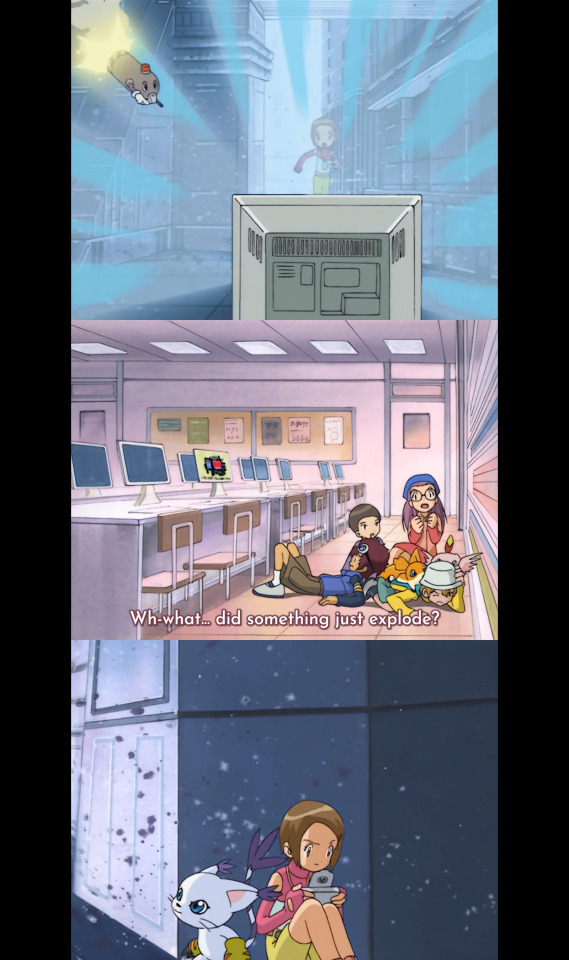
Well, four of them do, anyway.
Miyako: What the--!? Did something just explode!? Patamon: I saw it! A Guardromon attacked! Daisuke: Huh? Where's Hikari-chan? Iori: Oh no. Is she still in the Digital World?
She is indeed. Hikari and Tailmon take cover around a corner while Hikari emails the others on her D-Terminal.
Hikari: And sent. Tailmon: Hikari, if anything happens, I'll Armor Evolve. I can still fight. Hikari: Mhm! Thank you, Tailmon.
In the dub, Yolei remembers to say the thing while they're approaching the Gate.
Yolei: DIGI-PORT OPEN!!! (Everyone but Kari makes it through) Guardromon: GRENADE DESTROYER!!! Kari: Wait for me! (TV explodes and everyone but Kari escapes) Yolei: Ouch! Say, shouldn't we put pillows here if we're going to keep doing this? Patamon: Guys! I saw that the TV was blown up as we came through so we can't go back. Davis: Wait a second! Where did Kari go? Cody: She's trapped! In the Digital World!
Yolei makes a valid point.
Somehow Patamon managed to see the TV explode? In the original, they heard the explosion while they were transiting between worlds and Patamon saw the Guardromon fire just before he and Takeru went in, but here Patamon somehow managed to witness the entire thing.
The dub takes its first commercial break here, on the proclamation that Kari's trapped in the other world. We come straight back to Kari on the other side.
Kari: I'll send the others a message saying that we're okay. (typing noises) ...I don't think this has spell check. Gatomon: Kari, if we find ourselves in any kind of jam, I can always Armor Digivolve. Kari: Well, let's save that for a special occasion.
The key points are covered. She's sending a message and Gatomon can Armor Digivolve if they run into trouble.
That said, I don't know why they had Kari disagree with the plan. Next time we see Gatomon, she'll be in her Armor form. They aren't saving it for anything.
Back in the human world, Miyako tries but the Gate simply won't open to that region anymore. Because it's gone.

Miyako: No good. It looks like the Gate we used can't open anymore. Daisuke: Takeru, wasn't HIkari-chan right behind you!? Takeru: Mhm. Daisuke: What were you doing!? Why didn't you make sure she came through with you!? Iori: Daisuke-san, this wasn't Takeru-san's fault. Daisuke: Keep out of it, you noisy brat! Iori: (sternly) Please do not speak to me like that. Daisuke: (gently) S-Sorry, I was out of line. Takeru: No. Daisuke's right. It was my fault. I should have been paying more attention. Daisuke: No, when you put it like that... None of us even noticed. Not even me.
Iori successfully defuses this situation by accidentally provoking Daisuke into crossing a line that Daisuke immediately realizes he shouldn't have crossed, causing his rage to break.
Despite his general hostility to Takeru, Daisuke ultimately agrees that it's not Takeru's fault that Hikari got left behind. They didn't carry out on orderly retreat; They routed, with every child for themselves. The fault is on everyone.
In the dub:
Yolei: The Gate to that area is closed! We can't get to her! Davis: T.K., wasn't Kari right behind you when you went into the Gate from the Digital World!? T.K.: Mhm. Davis: Then it's all your fault! Why didn't you let her go first!? Cody: Stop! It was no one's fault! It just happened! Davis: What do you know!? You're a little kid! Cody: Yeah, but I still know when someone's being a jerk! Davis: (gently) Ugh... I guess that's me.... T.K.: The truth is, Davis is right. Davis & Cody: Huh!? T.K.: It really was my fault. I should have been watching out for her all along. Davis: Well... I guess I could have too. Cody: So could I. That's what I mean! There's no one to blame.
Pretty solid.
A sudden indicator from the computer alerts Miyako to a new email.
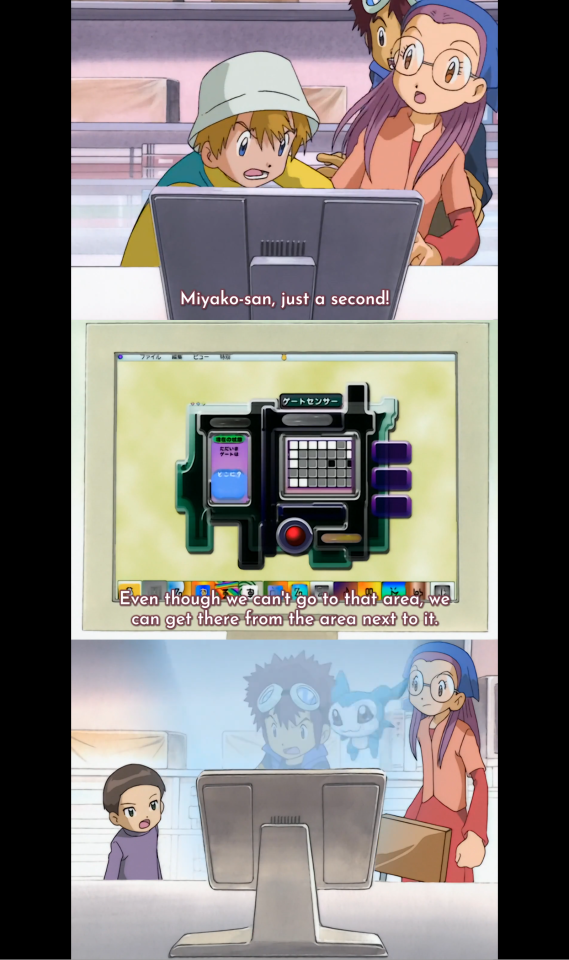
Miyako: Huh? Ah! An e-mail from Hikari-chan! "I'm safe. Don't worry. Takeru: Miyako-san, switch with me for a second.
Takeru suddenly gets an idea and takes over the computer. He scans through the map of the Digital World until he finds what he's looking for.
Takeru: Even if we can't go back to that area, we can enter the area next to it and cross over.
Takeru finds what he's looking for somehow, and I cannot make heads or tails of the map. He settles on a black square surrounded by gray squares which... I kinda thought gray squares were, like, the ocean or something and white squares were free territory, so I am lost.
But apparently this makes sense, so I'll go with it. Takeru finds his destination and holds his Digivice up to the screen.
Takeru: I'm going! Patamon: Wait, Takeru!
He's in such a hurry, he almost leaves Patamon behind. Fortunately, Patamon's able to flap over to him quickly enough to be caught up in the transition.
Miyako: Takeru-kun! Daisuke: Tch! I'm just supposed to let him take care of it!? Let's go, Chibimon! Chibimon: Yeah!
Daisuke, too, crosses over with Chibimon.
Miyako: Ah! Poromon, we should-- Iori: Please wait! It's almost dinner time. If Hikari-san and the others don't make it home, their families will worry and make a fuss about it. We should notify Taichi-san and the others first. Miyako: You're right... I'm the oldest here, so I should try to think more clearly. Upamon: If that's what we're doing, then hurry up! Poromon: Let's go! (Upamon and Poromon flee the room) Iori: AH!!! Don't go out on your own!
Iori and Miyako chase their excitable Partners from Computer Club, leaving Daisuke and Takeru to carry out this rescue mission by themselves.
In the dub, there is no email alert noise. There is, however, this ongoing AOL dial-up noise that starts playing and continues through the scene. Which is kind of like an email alert, I guess.
Yolei: Huh!? Hey, guys! It's an email from Kari! Davis: Huh!?
In addition to Yolei reading it out, the text onscreen is rewritten in English.
Yolei: It says, "Don't worry, I'm alright. And I'm sorry if any words are misspelled. Sincerely, Kari."
No words are misspelled so I didn't really get that joke.
T.K.: Yolei, I've got an idea! If I can find an area close to the one she's in, then I can reach her! (T.K. finds his destination) T.K.: Got it! I'll be back soon. Patamon: I'm going too! (T.K. and Patamon cross over) Yolei: What should we do? Davis: If he thinks I'm gonna stand by and let him be the hero, he can forget it! (Davis crosses over) Yolei: Haha what!? Then I'm going-- Cody: Yolei, wait a minute! Listen, it's almost dinner time right now. Somewhere between the green salad and the green gelatin, their families are going to wonder where they are! We have to tell Tai and the others! I think that's the best thing you and I can do to help Davis and T.K. right now. Yolei: Cody, I know you're just a kid but sometimes you have the wisdom of an old man of twenty! Upamon: Alright! What are we waiting for! Poromon: Let's go! (Upamon and Poromon go on their own) Cody: But wait! You can't just go out in public!
They had way too many lip flaps for what they needed Cody to say. XD
T.K. is a lot more reserved and in control of himself in this version. Takeru is clearly rushing off recklessly on an emotional impulse. He is, ironically, being the Courage boy right now.
The other side of the Gate opens into a vast stretch of desert. The boys make their way back to the machine city where they left Hikari.
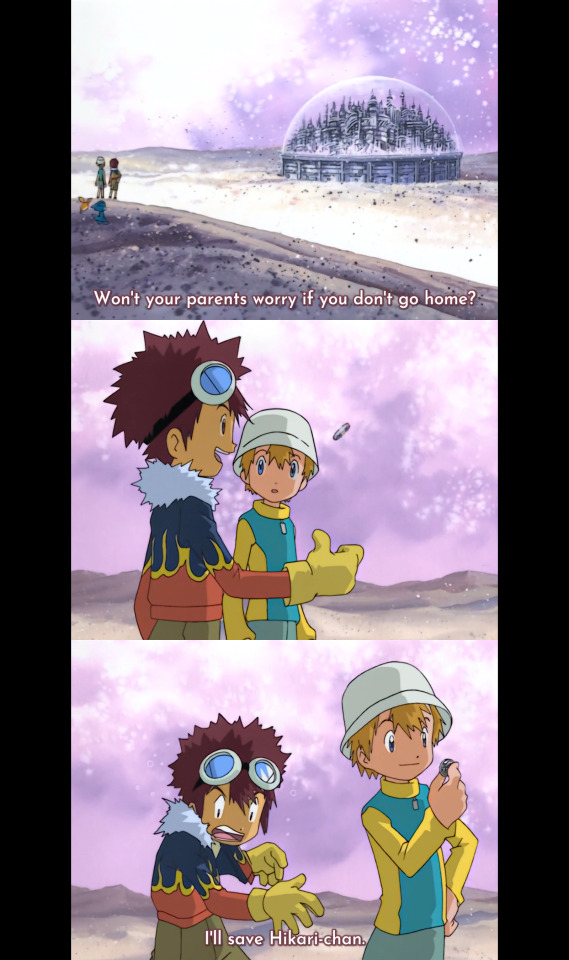
Daisuke: (calmly) Hey, Takeru. Takeru: Yes? Daisuke: The sun's going down. You should head home. Takeru: I'm fine. My mom will be out late today. But won't your parents worry if you don't make it home, Daisuke-kun? Daisuke: It doesn't matter.
That's an ambiguous statement. It's not clear if Daisuke means his parents won't care that he's gone, or that he himself doesn't care if they worry. Given the earlier "Jun always badmouths me" incident, either Daisuke's family kinda sucks or Daisuke's a little shit. Either is honestly plausible.
Daisuke fishes a coin out of his pocket.
Daisuke: So, who's going to go rescue Hikari-chan. We'll decide with a coin toss.
Daisuke tosses the coin and claps his hand over it.
Daisuke: Tails, you go home. Heads, I go home. (Daisuke reveals Tails) Daisuke: Tails! (gloating) Looks like I'll be the one to save Hikari-chan--
With a shit-eating grin, Takeru snatches the coin from Daisuke's hand and inspects it himself. He clearly knows exactly what he's going to find.
Takeru: Both sides of this coin are Tails, right? They sell these at Kadoetsu. Daisuke: (embarrassed) Y-You knew...? Takeru: (smiling) Let's go together. Daisuke: ...okay.
Takeru once outsmarted literal bullets. You're gonna have to get up a lot earlier in the morning to pull a fast one on him.
As the boys make their way into the city, their Partners briefly unpack what just happened.
Patamon: Why not do that from the start? This was stupid. V-mon: Don't say that. He was just trying to look cool....
Daisuke still feels like he has a lot to prove.
In the dub:
Davis: (bickering) This was a great idea! Crossing the desert without any water! T.K.: (bickering) Look, I didn't ask for your help! Davis: There's the city! T.K.: Looks like one of those things you shake and it starts snowing! Davis: I'll go get Kari! You wait here. T.K.: No, I'll get Kari. You wait here. (Davis fishes a coin out of his pocket) Davis: Alright, I'll tell you what. We'll flip for it. Winner goes, loser stays here. Since it's my coin, I get to call it. Tails! (Davis flips) Davis: Okay, if it's Tails, I rescue Kari. If it's Heads, you get to go. (Davis reveals Tails) Davis: Tails! (gloating) I'll tell her that you were worried about her and that you-- (T.K. snatches the coin and inspects it) Davis: WAUGH!!! T.K.: Huh. A coin that has Tails on both sides. That's how I used to beat Matt. Davis: H-How about that.... T.K.: Let's both go. Davis: ...okay, T.M. Did you really use one of those coins on Matt? T.K.: Yeah, that's how I got all my baseball cards and his old guitar. Patamon: T.K. and Davis sure argue a lot. How come? Veemon: Something about Kari. Human girls make human boys act sorta weird.
Let's start with the good. Takeru recognizes the trick coin from seeing it in a store, but T.K. has a more personal anecdote about it that adds a bit of depth to his relationship with his brother. This is good, especially with the way Davis and T.K. use added dialogue to bond over it.
Now for what I don't like. I don't like that they're playing Daisuke's one-sided rivalry with Takeru as a more traditional Love Triangle, with both boys aggressively locking horns with each other. The first anime dub papered over a lot of Takeru's growth, strength, and developing maturity and this scene continues that trend.
This is a strong moment for Takeru. It's the first time he's been alone with Daisuke. He wastes little time cutting through Daisuke's childish obstinance and jealousy, and bringing him around on-task. Takeru takes Daisuke by the shoulder and lifts him up to Takeru's level, while the dub drags T.K. down to Davis's level.
Meanwhile, in the city, things are already going south for Hikari.
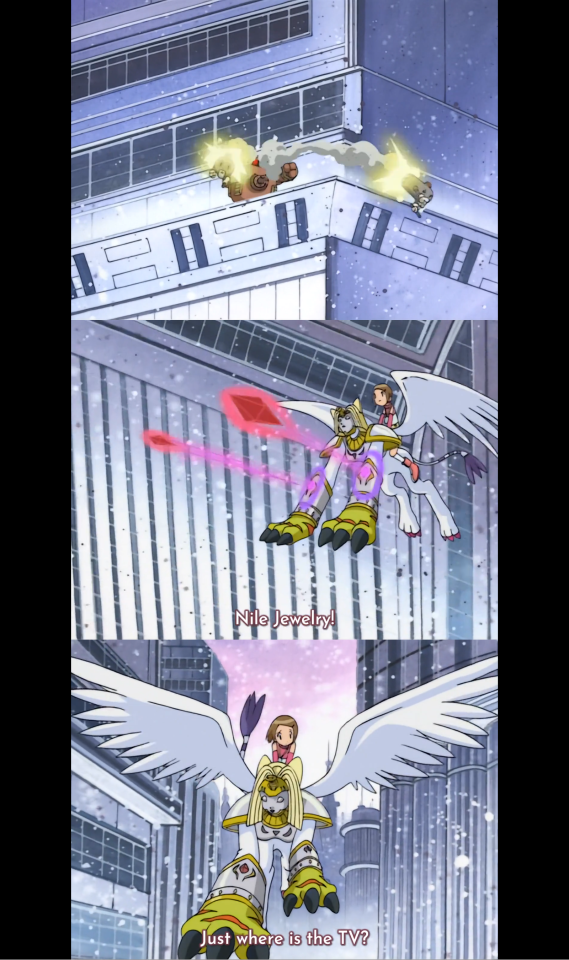
Guardromon: INTRUDER. INTRUDER.
Hikari flies through the sky on Nefertimon's back, fleeing enemy Guardromon. One Guardromon pops out ahead of her, firing Destruction Grenades her way.
Nefertimon: NILE JEWELRY!!!
Nefertimon returns fire, blasting the enemy projectiles out of the air and giving her cover to sweep past.
Nefertimon: Where the hell is that TV!? Hikari: There really aren't any left in this area. We have to find a way out of here!
In the dub:
Guardromon: INTRUDER. INTRUDER. (Guardromon up ahead fires) Nefertimon: ROSETTA STONE!!! (Nefertimon parries the attack and sweeps past) Nefertimon: Kari, there aren't any TVs left in this area. Kari: We'll have to go to another area to find one. Nefertimon: But we don't even know which direction to travel.
I mean. If the destination is "somewhere else" then any direction is good, really.
As with Takeru's more neutral decision to return, the words are the same but the emotion is lost. Kari and Nefertimon don't sound pressured as heavily by their situation; Instead, they calmly explain their predicament to each other for the audience's benefit.
Unfortunately, it quickly becomes clear why Hikari can't lose her tail: From his control room, the Digimon Kaiser has eyes on her. In fact, he has a frankly ludicrous number of monitors dedicated to differently angled closeups of her face. That's weird. You're weird, Digimon Kaiser.
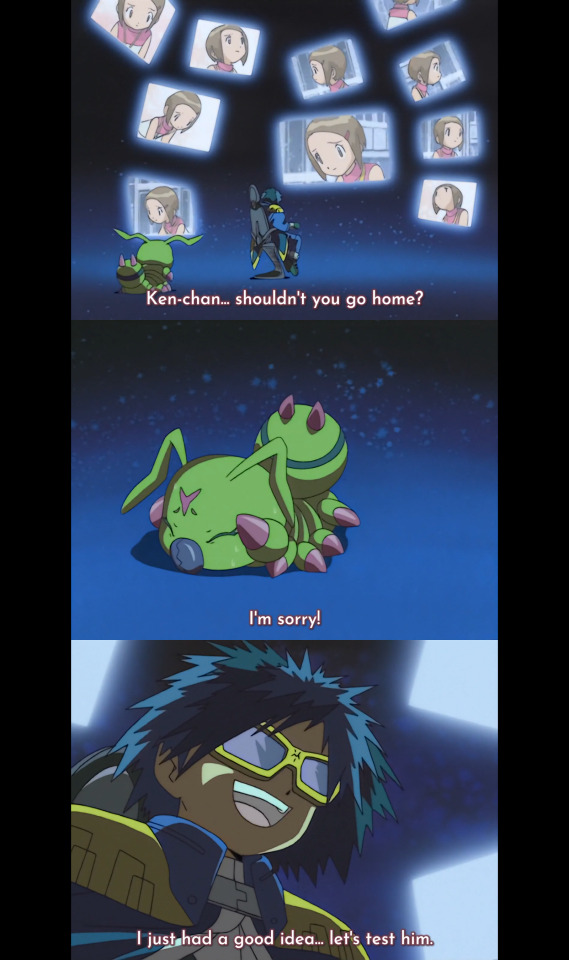
Kaiser: Huhuhu.... Wormmon: Ken-chan, shouldn't you be getting home?
More and more, Wormmon's starting to get a response from the Kaiser. He turns his head away from the screens to glare at Wormmon for a second before responding.
Kaiser: HAVEN'T I TOLD YOU NOT TO CALL ME THAT!?!? Wormmon: (cowers) ACK!!! I'M SORRY!!!
Wormmon tenses up as if bracing to be struck. But when no strike comes, he opens his eyes and looks back up at the Kaiser. The Kaiser's focus is back on the screen, and he summons his holographic control panel.
Kaiser: Here's a fun idea. Let's test out this one.
He presses a key, causing Digital World coding to appear on the monitor.
Wormmon: (gasp) That code is... Perfect stage!? Kaiser: Huhuhuhuhuhu....
We've never seen the Kaiser control a Perfect Digimon before. We don't know if he can do it. He might not know either, given that he describes this as a test.
In the dub:
Emperor: Hahahahahahaha! Wormmon: It's almost your dinner time. Shouldn't you be going home soon, Ken? Emperor: .... (beat) Emperor: NEVER CALL ME ANYTHING BUT MASTER!!! Wormmon: (wordlessly cowers) Nrrrrrrgh.... Emperor: Since she's ~all alone~, she deserves someone ~special.
The Emperor manages to make that sound even creepier than the many closeup monitors already were. On purpose, I'm sure. He knows what he's doing.
(Kaiser activates the new minion) Wormmon: Oh no, you can't! Anyone but him! Emperor: Huhuhuhuhu....
Wormmon addressing the Emperor as Ken seems out-of-place here. Depending on how you look at it, this can either be better or worse for the dub.
On the one hand, we lose the consistent character trait of Wormmon calling him Ken-chan since day one, which the Kaiser finally reacts to. It's never come up before because Wormmon, until recently, has been beneath the Kaiser's notice.
Dub Wormmon accidentally slipping up here and provoking this reaction retroactively justifies the decision to avoid using Ken-chan for the past six episodes. For him, the Emperor has been "Ken" to him all this time. However, as a learned behavior, he knew better than to say it out loud.
Both of these interpretations of his character work really well for Wormmon's relationship to the Kaiser/Emperor and to Ken.
What we lose here is the specific threat that, for the first time, a Perfect-stage Digimon is about to go Hikari Hunting. We don't know how the Armor Digimon will measure up to that! This could be really bad!
Instead we just get... "him". Not "him"! How will Kari ever be able to defend herself against "him"!
Back in the human world, Iori uses a pay phone outside of the Inoue family convenience store. Giving us a good shot of the store's name, too.

The store is called アイマート Aimaato or "I-Mart", presumably for the family name Inoue. The banner underneath reads 愛と純真のお店 Ai to Junshin no Omise or "The Shop of Love and Purity".
Well, now we know how Miyako's Digimentals were assigned. Somebody was shopping around Odaiba for new Chosen Children, saw that banner, and. Like. Who could possibly pass up the chance to do something really funny with that?
Iori: Ah, is this Yagami-san? Good evening, this is Hida Iori.
Inside, Miyako's loading up a grocery bag while her unnamed father works the counter.
Dad: Miyako, when one of your siblings gets back, can you ask them to watch the counter? Miyako: Okay, got it.
Cut to the Yagami home. Iori's explaining everything to Taichi over the phone.
Iori: So that's what's happening. Taichi: I see... Hikari is.... No, you don't have to apologize, Iori. I got it. Bye.
As he hangs up, his mother Yuuko turns around from the kitchen to find out what that was about.
Taichi: (big fake smile) Apparently Hikari's hanging out a friend's house. I'll go pick her up.
I'm a bit more forgiving of Taichi lying to his mom here than I was in Our War Game. That unnecessary lie concerned a global catastrophe that nearly resulted in Odaiba getting nuked, so there was a clear and obvious reason why Taichi and Koushiro needed to be doing Digimon Shit. They were the only people who could stop Diablomon from eating the entire global infrastructure.
She might be less understanding of "Yeah, Hikari went back to the Digital World to get shot at with robot bullets because some guy's causing trouble to some people far away, in a way that doesn't affect us at all." This is not an end-of-the-world crisis and so I think for most parents, it would easily set off their "Okay but not my children" reflex.
To a concerned parent, Digimon Kaiser sure does sound like the Digimon's problem. You have school in the morning, young lady, and I don't want you attending that school with your face exploded.
In the dub:
Cody: Hello? Can I speak to Tai, please? ...no, I'm not selling anything!
Yeah, that's about right. The only reason this American stock gag has aged poorly is that in the modern day, Tai's mom wouldn't have answered for an unknown caller at all.
Yolei's Dad: (sternly) You know, Yolei. With all the snacks and drinks you take to give your friends, it's a wonder this store shows any profit at all! Yolei: Put it on my tab, Daddy!
Yolei's dad nags at her about the financial impact she's having on their business. This seems unreasonable since it was previously established that she works off everything she takes.
It's Miyako who's the primary cause of the store's shrinkage. Yolei's family is just... aggressively capitalist. They employ a 12-year-old child laborer and pay her in merchandise, then complain that she takes too much compensation.
They better not cut her pay. Yolei's learning about the power of collective action against fascism in her extracurriculars at school right now. She might transfer some of that and unionize her siblings.
Cody: So that's where Kari is now, Tai. Tai: Okay, Cody. Thanks for letting me know. Don't worry about it. I'll take care of everything. (Tai hangs up) Tai: Kari's at a friend's house doing a science project on gravity and they need to see how long I can stand on my head. See ya!
Tai opts for the "excuse so bewildering that he'll be out the door before his mom's finished processing how little sense that makes" approach. XD
Once out the door, Taichi and Yamato meet up outside.

Yamato: Taichi, did you hear from Iori? Taichi: Yeah. We need to get down there fast. But first, we should tell Daisuke's parents something. Yamato: Got it. Let me take care of that. You hurry up and go find Hikari-chan. Taichi: Got it! I'll leave this to you, then!
Taichi turns and sprints off for Odaiba Elementary, leaving Yamato to figure out what he's going to--
Yamato: (startled) I was supposed to make dinner for Dad today! (casually) Eh, oh well.
Fuck Hiroaki, I guess. XD He can starve.
Back at I-Mart, Miyako takes her grocery bag of loot and meets back up with Iori outside.
Iori: I called home and said I'd be a little late. What about you, Miyako-san? Miyako: Well, I think my dad asked me to do something but who cares. Let's go!
So much parental respect happening tonight. XD Kids.
In the dub:
Matt: (casually) Hey Tai, I heard what happened. So, are you going to go? Tai: Yeah, in a few minutes. But first, I have to make a stop by Davis's apartment. I have to make up a story to tell his family that he's going to be a little late tonight. Matt: Ehhhh, don't worry about that. I can take care of it! You go on and get to Kari. Tai: Right! Thanks, Matt! (Tai runs off) Matt: (startled) Oh, I forgot! I left Mimi on hold when she called from New York! HER PHONE BILL!!!
...Matt broaches this subject like the rumor mill's been talking about Kari, and clearly indicates that he's not coming and is just wasting Tai's time for small talk.
The only reason Yamato isn't coming too is because they needed to split tasks and it makes more sense for Taichi to go rescue his little sister.
Matt further indicates that he had no intention of coming and was just stepping out to talk to Tai by indicating that he's actually in the middle of a phone call with Mimi right now. Fortunately, Dub Mimi is fabulously wealthy so I think her phone bill will be fine.
Cody: I told my mom we were working on a rescue project. She said she's glad we're helping stray cats in the neighborhood. Yolei: Yeah, my dad was just glad that I left without filling up another bag!
And the censors are probably glad that Matt and Yolei aren't encouraging children to talk back to their parents. I bet that's what's going on here.
Back in the Digital World, Takeru and Daisuke take cover atop a dune to scout the front entrance to the machine city.
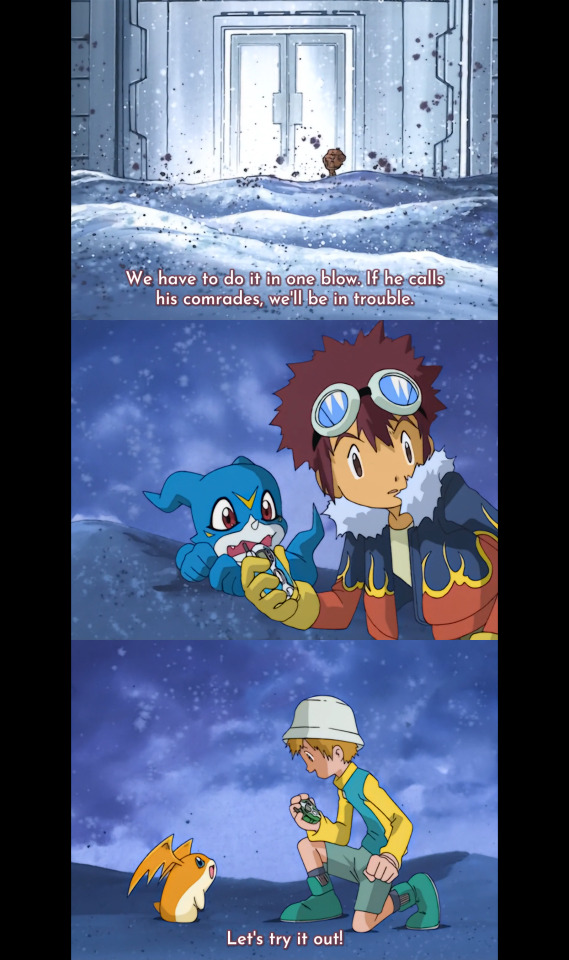
Takeru: That seems like the entrance, but....
A single Guardromon is keeping watch outside the door.
Daisuke: We'll have to defeat that one if we want to break in. Takeru: We need to finish it in the first shot; This will get a lot harder if they call for backup. V-mon: Alright, Daisuke! Daisuke: Yeah! Patamon: Wait! Takeru, this area doesn't have a Dark Tower, right? Takeru: Yeah, there's just the one inside that dome. Patamon: Then that means.... Takeru: You're right! We don't need Armor Evolution! Daisuke & V-mon: Huh? Takeru: Let's try it! Patamon: Yeah!
Daisuke has no idea what Takeru means but he's about to see some shit.
In the dub:
Davis: There's just one guard at the door! T.K.: We're gonna have to take him out in the first attack. Otherwise, he'll call for reinforcements. Davis: Not a problem. Veemon and I can handle that metalhead. Veemon, are you ready? Veemon: Yeah, let's do it! Davis: DIGI-ARMOR-- Patamon: Wait a minute! I'll do it. There aren't any Control Spires in this area, right? T.K.: Well, just the one inside the dome. Patamon: But we're outside. T.K.: Yeah! That's right! That means you can Digivolve! Davis & Veemon: Huh? T.K.: Then go for it. Patamon: Alright!
Solid. I like that they have Davis get partway through the Armor incantation when Patamon interrupts him. That's neat.
Foregoing his Digimentals, Takeru and Patamon do this old-school. Patamon SHINKAAAAAA!!!

To the sound of Show Me Your Brave Heart, Angemon appears in a humongous pillar of holy light that definitely should have given their position away and put the machine city on alert. But I guess the Kaiser is too busy ogling Hikari from many angles.
Takeru: YES!!! You can use your normal evolution!
Daisuke's jaw practically hits the sand at the sight of Takeru's Adult Partner.
Daisuke: Eh... Angemon...!?
Takeru and Angemon reply only with mirrored satisfied smiles.
In the dub:
T.K.: Angemon! I haven't seen you in a while! Davis: Ehhhh!? An... Angemon...!? Veemon: ...hi there, big guy....
They have T.K. call out Angemon by name so it flows better when Davis says it. Daisuke probably just heard Angemon say his name during the transformation sequence but it's never really clear how diegetic those are supposed to be.
It's go time. Angemon takes off across the sand, sailing for the Guardromon.
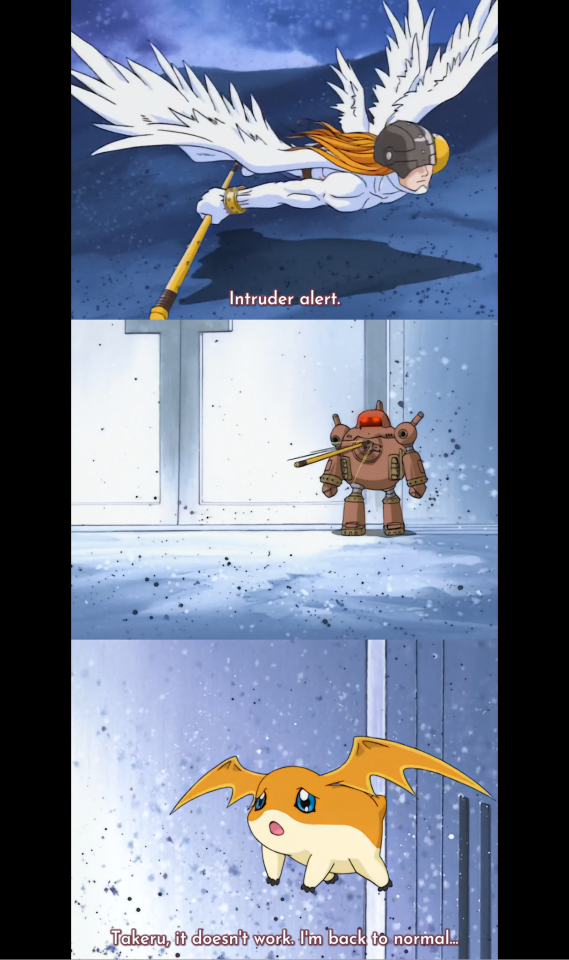
Guardromon: Suspicious person approaching--
Angemon tosses his Holy Rod, nailing Guardromon right in the Evil Ring around their valve and breaking it off.
Angemon: Now! Hurry!
Daisuke, Takeru, and V-mon sprint across the sand to join Angemon at the front door. Angemon punches through the latch, opening the door and letting them inside. However, once they enter, the power of the Dark Tower regresses Angemon back into Patamon.
Patamon: Takeru, it doesn't work after all. I'm back to normal. Takeru: It was worth a try.
I'm honestly not sure why it doesn't work. It's been well-established that the Dark Towers suppress evolving but evolved Digimon retain their form when they enter the Tower's domain. We saw Birdramon, Greymon, and Garurumon taking down Dark Towers as recently as the opening minutes of this episode.
Between this and Jou's episode, the mechanics of the Dark Towers seem wildly inconsistent.
In the dub:
(Angemon flies towards Guardromon) Guardromon: INTRUDER. Angemon: ANGEL ROD!!! Guardromon: INTRU-- (struck) --DERRRRRRrrrrrrrr... (shuts down) Angemon: I nailed it. (The team breaks in, but Patamon regresses) Patamon: You know, those Control Spires really ruin my day. T.K.: You did great, Patamon.
Angemon calls his rod throw as an attack.
Again, this is really good. I love the effect on the Guardromon getting hit halfway through speaking and verbally breaking down.
Once inside, Daisuke has questions. Serious questions.
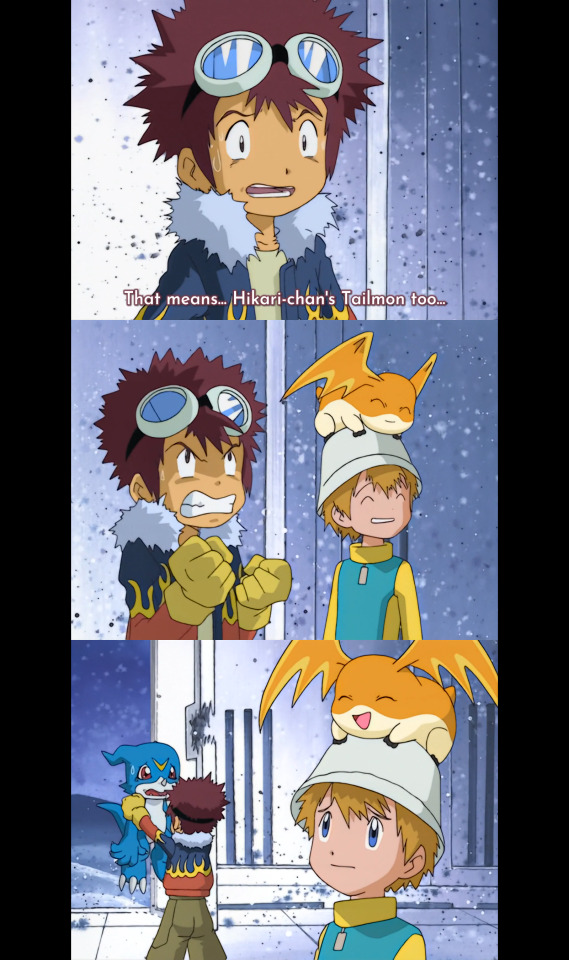
Daisuke: Just now, Angemon... Patamon can also evolve like Agumon? Takeru: Of course, as long as there isn't a Dark Tower around. Daisuke: Then that means... Hikari-chan's Tailmon also.... Patamon: She becomes Angewomon! Daisuke: Eh!? Angemon and Angewomon!? Patamon: Yeah! We're a perfect match, right, Takeru? Takeru: (noncommittal) Ehehehe....
Predictably, that remark from Patamon triggers Daisuke, who whirls around on V-mon.
Daisuke: V-MON!!! V-mon: Wha!? Daisuke: Then you need to become UltraAngemon! V-mon: Ehhhhhhhh!?
Daisuke picks up V-mon and shakes him.
Daisuke: Do it! You have to do it! DO IT WITH ALL OF YOUR WILL!!! V-mon: Y-You're out of your mind!
Watching Daisuke melt down like this, Takeru admonishes Patamon for what he said.
Takeru: (to Patamon) Don't tease him like that! Patamon: (shit-eating grin) Ehehehehehe!
Patamon regrets nothing. Poor Takeru. This is not productive.
Though it's certainly clear by this moment that it isn't just Hikari; Takeru and Patamon have also picked up on the source of Daisuke's hostility towards Takeru. Daisuke is extremely obvious about his unrequited crush and everybody knows.
In the dub:
Davis: So, besides Armor Digivolving, Patamon can Digivolve to Angemon? What about Gatomon? T.K.: Well, she can Digivolve to Angewomon. Davis: You're kidding me! Angemon and Angewomon!? Patamon: That's right! We make a great team. Davis: One question: Is there an AngeBabymon too? Patamon: (to T.K.) Sometimes he says the weirdest things. T.K.: Ahahahaha. Davis: RRRRRRRGH!!! VEEMON!!! Veemon: Huh? Davis: Tell me right now if you can Digivolve into AngeSomething too! Veemon: Uhhhhhhhh... (Davis picks up Veemon and shakes him) Davis: AngeDinosaurmon! AngeSoccerPlayermon! Veemon: I just don't have it in me! T.K.: (to Patamon) He's still got a lot to learn. Patamon: Ahaha!
So here we have the opposite problem from the desert scene earlier, when T.K. was being dragged through Davis's muck. They speed through the Gatomon part early so they can skip right to having fun at Davis's expense. In the process, they also remove the part where Patamon deliberately provokes him and sets him off.
Davis loses it of his own accord while T.K. and Patamon privately chitchat about how weird and childish he is.
At the Motomiya home, Jun answers the door for Yamato.
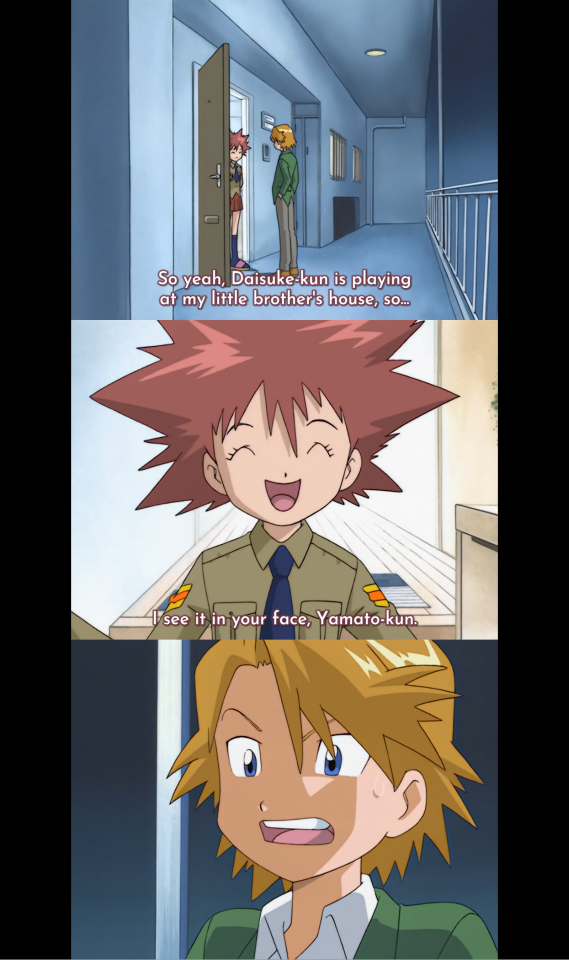
Yamato: So you see, Daisuke-kun is still playing over at my little brother's place. Jun: ^_^ Ehehehehe.... Yamato: What? Jun: You're lying, huh? Yamato: O_O Jun: Your lies are painted on your face, Yamato-kun. Yamato: O_O (frozen) Jun: It's fine, I'll relay your message. And in exchange, you'll take me on a date, okay? (Jun goes back inside) Yamato: D...date...!?
Dub's over there dunking on Davis but I need to point out that this is way worse than anything Daisuke's ever done. Jun is extorting Yamato into going out.
We made a terrible mistake. Should have sent Taichi. He bullshits seamlessly and he's undesirable so this would have gone much smoother.
In the dub:
Matt: So anyway, Davis is over at my brother's house and so he probably won't be home until a little later on. Jun: ^_^ Ehehehehe.... Matt: What? Jun: You're lying. Matt: O_O Jun: I can tell when people are lying 'cause they usually start blinking a lot. Matt: O_O Wha--but--ahaha-- Jun: I promise not to tell my parents you were lying if you promise to go out on a date with me. Okay? See you Friday at eight. (Jun goes back inside) Matt: ...how did that happen!?
Dub Jun's more proactive than her Japanese counterpart and sets an exact time for Matt to pick her up, while the original leaves it up to him to figure out the details.
Over at the school, Miyako's holding down the fort with Upamon and Poromon. She and the Digimon are munching on the snacks she brought from I-Mart.
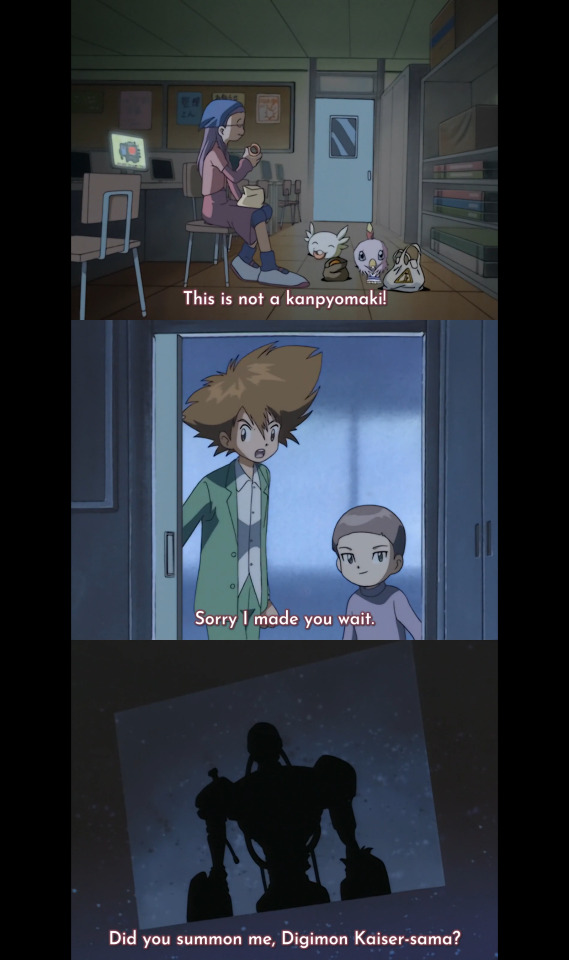
Poromon's sucking down some ChuChu Jelly, but he's still unhappy about last episode.
Poromon: This is not kanpyoumaki! Miyako: Don't be picky.
Poor Poromon.
Iori returns, having gone to meet Taichi outside and smuggle him in.
Iori: Yagami-san is here. Taichi: Sorry to keep you waiting.
Cut to the Digimon Kaiser's Control Room, where an awfully familiar silhouette appears onscreen. The Perfect Digimon he's taking for a test drive.
Andromon: Did you call for me, Digimon Kaiser-sama?
And that is an ominous spot to take a commercial break!
In the dub:
Poromon: How come he gets more candy than I do!? Yolei: Stop complaining; There's plenty more. (Cody arrives with Tai) Cody: I brought some reinforcements! Tai: Let's get to work! (Meanwhile, in the Emperor's command center) Andromon: You summoned me, Your Highness? Wormmon: Please hold for the Digimon Emperor. Line 1 for you, sir.
I'm not sure why they didn't let Poromon still be upset about his sushi. That did happen last episode. Maybe they figured kids wouldn't remember well enough to get the reference.
The dub also takes its second commercial break here. It's a good spot for it.
We come straight back from commercial to a dual Armor Evolution sequence.
Daisuke & Takeru: DIGIMENTAL UP!!!
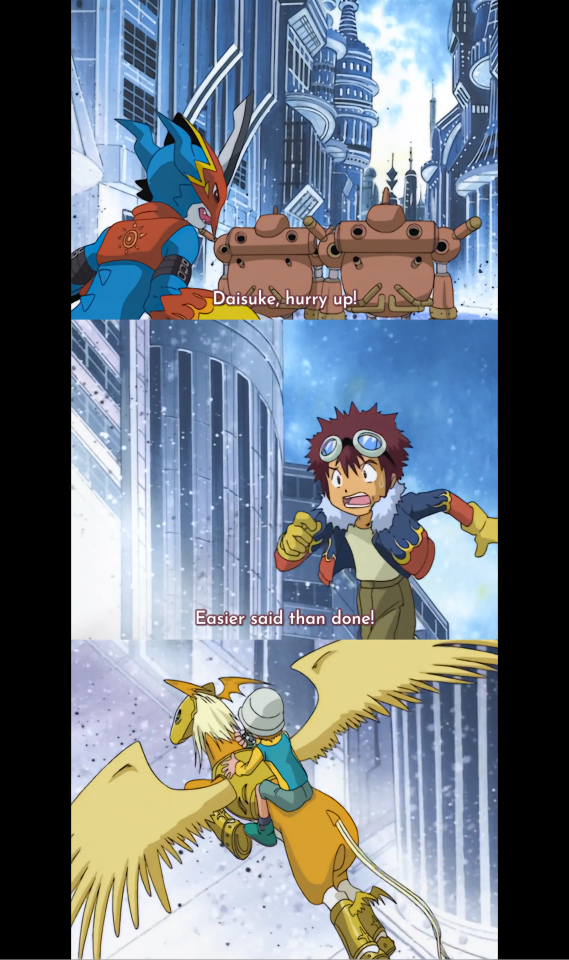
Fladramon: KNUCKLE FIRE!!!
While Takeru and Pegasmon soar above the Guardromon units with ease, Fladramon is forced to blaze open a path for Daisuke on foot. His Fire Knuckle neutralizes the Evil Rings on two Guardromon units, who he clears with a leap.
Fladramon: DAISUKE, HURRY!!! Daisuke: (panting) Easy for you to say!
Come on, Daisuke! Put those soccer legs to work! You know how much long-distance sprinting we had to do back on Server Continent? BACK IN MAH DAY--
For his part, Takeru uses his Digivice to track Hikari's.
Takeru: She's close!
In the dub:
Flamedramon: FIRE ROCKET!!! (Flamedramon takes out two Guardromon and hurdles them) Flamedramon: DAVIS, OVER HERE!!! Davis: I can't jump as high as you can! (T.K. follows his Digivice) T.K.: I'm getting Kari's signal! We're close!
Solid.
This whole city sprint thing isn't workout out for Daisuke and Fladramon, so they decide to try something new.

Fladramon picks up Daisuke with his left arm.
Fladramon: Hang on tight. Daisuke: Yeah!
With Daisuke very loosely secured, Fladramon bounds to the roof of a building, then hops through the city.
Daisuke: (quietly) Ahhhhhhhh! ...huh?
At the height of Fladramon's jump, Daisuke briefly spots Nefertimon flying through a nearby street.
Daisuke: There! It's Hikari-chan!
And not a moment too soon. A glancing shot from a Destruction Grenade knocks Nefertimon out of the air, sending her and Hikari tumbling into the street below. They land hard, throwing Hikari from the force of impact before Tailmon's stamina well bottoms out and she loses her form.
In the dub:
Flamedramon: You ready to jump a little higher? Davis: (reluctant) Well.... (Flamedramon jumps) Davis: --WAUGH!!! (Flamedramon bounds above the city) Davis: AHHHHHHHHHHH--huh? (Davis spots Nefertimon) Kari: Boy, am I glad to see you! Guardromon: GRENADE DESTROYER!!! (Guardromon shoot Kari down. Gatomon loses form) Guardromon: INTRUDER. DESTROY. Gatomon: (hiss)
XD Davis having second thoughts got me.
For some reason, they have Kari notice Davis too, despite facing the opposite direction far below him. This doesn't affect anything, though. It's a harmless change. Just odd.
Despite their crash landing, Hikari and Tailmon still manage to pick themselves up as best they can with what little strength they have. They grit their teeth and face down the enemy's advance.
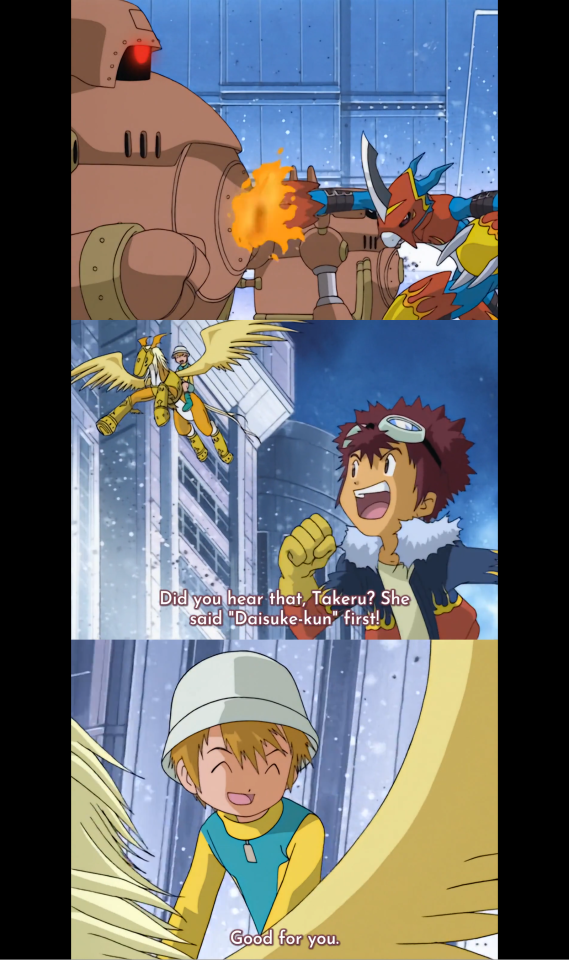
Pegasmon: SILVER BLAZE!!! Fladramon: KNUCKLE FIRE!!!
That's a new one from Pegasmon. Silver Blaze is a triangular beam he fires from a triangle mark on his helmet. Fladramon's using an oldie but a goodie, but he goes far enough to punch his Knuckle Fire directly into Guardromon's Evil Ring himself.
Hikari: Daisuke-kun! Takeru-kun! You came back for me! Daisuke: Hehe, did you hear that, Takeru? She said 'Daisuke-kun' first! Takeru: ^_^;; Good for you.
Takeru's line here is a little ambiguous. His face is all smiles but his delivery is strained and quiet. Is Takeru a little exasperated by Daisuke's Daisuke-ness that's been on full display all episode, or is he actually jealous about that? You decide.
While Daisuke hurries on ahead, Takeru spots a flanking Guardromon coming down a side alley. He peels off to take care of that.
Pegasmon: NEEDLE RAIN!!!
While Takeru and Pegasmon are dealing with that, Daisuke and Fladramon get Hikari on her feet.
Daisuke: Come on, Hikari-chan! Hurry!
In the dub:
Pegasusmon: EQUUS BEAM!!! Flamedramon: FIRE ROCKET!!! (Pegasusmon and Flamedramon neutralize the enemy) Kari: Hey, Davis! T.K.! You guys are my heroes! Davis: Actually, it was mostly my idea but I decided to bring T.K. along for the ride! T.K.: Whatever! ...huh!? (T.K. peels off to deal with that flanking Guardromon) Pegasusmon: STAR SHOWER!!! (Pegasusmon takes out the enemy while Davis gets Kari on her feet) Davis: Come on, Kari, we'd better get going!
I don't think we're meant to take Davis's line here as him literally trying to take all the credit. Since the animation has him looking up at T.K. as he says it, it comes off more as a playful ribbing to T.K., conveying that they may be getting along better.
Ironically, as the lyrics to Break Up end on "It's time to go!", Daisuke and Hikari find their path blocked. Andromon steps out into the road ahead of them. An Evil Ring is fixed around his neck, though it blends in pretty well with his color palette.
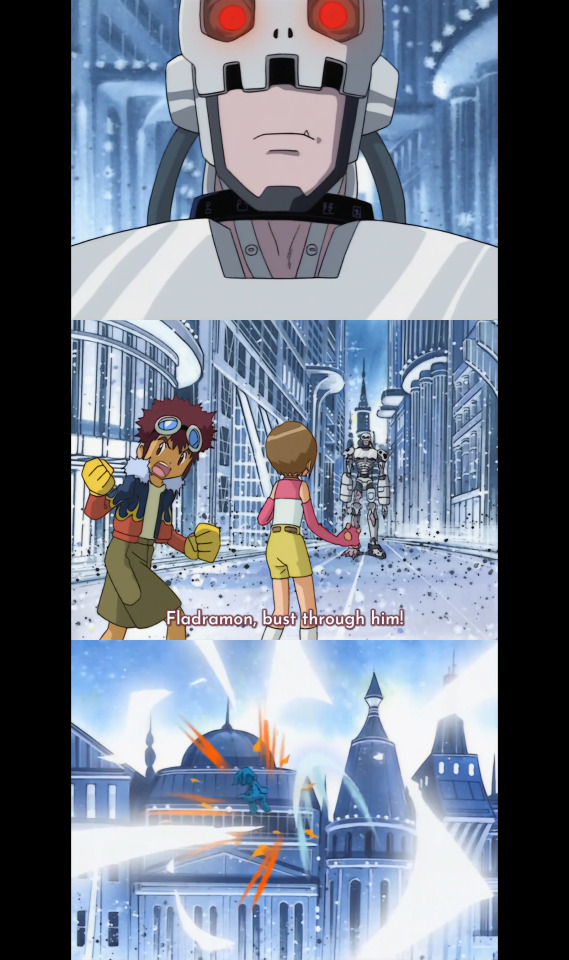
Daisuke: It's a different one this time! Hikari: (excited) Andromon!
For his third rundown in two series, Andromon is a Perfect-stage Vaccine-attribute Cyborg Digimon. The Chosen Children minus Hikari first met him on File Island, in ironically similar situations to where they are now. Then, he was in charge of a machine factory but he was under the control of Devimon's Black Gear.
They met him again, with Hikari, on Spiral Mountain. Andromon was leading a solo resistance against the Metal Empire. He ended up signing on with Taichi's team to see things through to the end.
And now here he is, fixed with an Evil Ring around his neck. It seems that it's Andromon's curse to always be wherever evil seeks to dominate the machines of the Digital World.
Narrator: Andromon! An experimental Perfect-stage cyborg Digimon. They use their arms to fire their special attack, Spiral Sword!
Pretty sparse rundown. I guess the narrator's getting bored of having to go back and talk about this guy again.
As the rundown ends, Hikari's excitement evaporates. She sees the Evil Ring around Andromon's neck.
Hikari: (gasp) ...Andromon.... Andromon: On order of the Kaiser-sama: The Chosen Children must be eliminated. Hikari: STOP IT, ANDROMON!!! Don't you recognize us!? Daisuke: What are you talking about, Hikari-chan!? Fladramon, clear the path! Fladramon: On it. FIRE ROCKET!!!
We don't know how Armor Digimon measure up to Perfect but we are about to find out. Fladramon takes to the air, using the actual Fire Rocket that the dub's been misusing the name of. Wreathing his body in flames, he shoots down towards Andromon.
Andromon: SPIRAL SWORD!!!
Fladramon goes down in one shot. Spiral Sword breaks through Fire Rocket and slams into Fladramon's face with so much force that it breaks his Armor form. The Digimental of Courage returns to Daisuke while V-mon plummets helplessly into the street below, landing on the back of his head.
Daisuke: V-MON!!! (Daisuke runs to V-mon) Daisuke: Hey, hang in there! V-mon: (pained) I've never seen such a powerful attack before....
Indeed, he has not.
In the dub:
Davis: Why can't these guys ever be small!? Kari: (excited gasp) ANDROMON!!! Andromon: (rundown) I am Andromon! I have one mission: Seek out my enemy and destroy him with my Lightning Blade. Kari: Huh!? He's got a Dark Ring! Andromon...? Andromon: I am programmed to destroy the enemy. You are the enemy. I will destroy you. Kari: Andromon, don't you remember us? We're your friends! Davis: Kari, you're hanging around with the wrong people. Flamedramon, you'll have to use all your power! Flamedramon: You got it! FLAMING FIST!!! Andromon: LIGHTNING BLADE!!! (Andromon knocks Veemon out of form) Davis: Whah!? (Davis runs to Veemon) Davis: Veemon, speak to me! Veemon: (pained) You're kneeling on my tail....
Knuckle Fire is Fire Rocket while Fire Rocket is Flaming Fist. That makes sense.
I like that Kari's transition from exuberance to dismay seems to have been prompted by Andromon's diegetic rundown. Like hearing him say that was her first clue that something's wrong. Since characters are explaining the rundowns in-universe, it's fun when other characters react to them.
I think "You'll have to use all your power" is supposed to explain why Veemon lost his Armor form after being his attack was deflected. In the original, Andromon just hit him that hard. Fladramon ran face-first into the brick wall of Evolutionary Power Levels.
This is the File Island factory all over again, with Andromon manhandling Greymon and Garurumon simultaneously while the Children watch with WTF printed on their faces.
Like before, when they were dialed back the exhaustion factor, the dub uses that line to tone down how hard Veemon was hit here. They also scrub Veemon's line explaining how powerful Andromon's attack was, swapping it for a laugh line with alternative explanation for why Veemon is in physical pain.
Startled by what just happened, Pegasmon drops off Takeru. Takeru breaks for Daisuke and V-mon while Pegasmon engages the enemy.
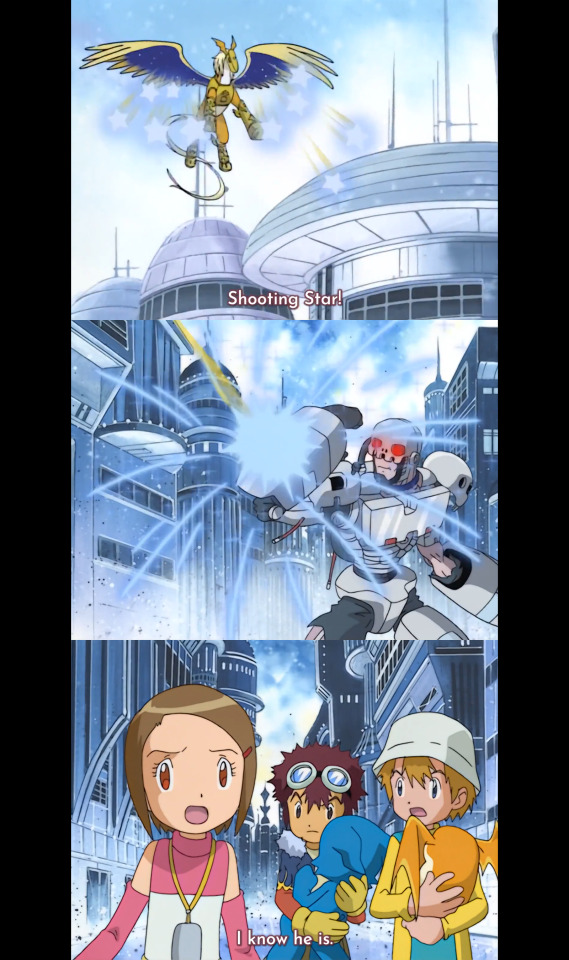
Pegasmon: SHOOTING STAR!!!
Pegasmon's wings open to unveil the cosmos, and he launches a set of star-shaped projectiles from them. Very cool, but also kind of a spray-and-pray. Only one star actually reaches Andromon, who effortlessly blocks it with one arm.
Andromon: SPIRAL SWORD!!!
Pegasmon won't be defeated so easily as Fladramon. He flits down and to the side, evading Andromon's attack and--
Pegasmon: GACK!!!
The arcing blade curves around in midair and strikes him in the back. Pegasmon is defeated as easily as Fladramon. We don't see the moment of impact, but the Digimental of Hope returns to Takeru's pocket while Patamon falls helplessly into Takeru's arms.
Patamon: (defeated) I knew Perfect-stage would be too strong.... Daisuke: Perfect-stage!? The hell is that!?
Daisuke doesn't get an answer because Hikari chooses now to roll a Charisma check instead.
Hikari: Andromon, have you forgotten that we fought together? Takeru: Hikari-chan, we don't even know if this is the same Andromon from back then! Hikari: I know they are. Takeru: Even so, they're being controlled by that Ring. Your voice won't reach them. Hikari: You're wrong!
Hikari's pinning a lot of trust on an avenue that has, up to this point, shown no sign that it could work and every sign that it would not. But she wouldn't be queen of the Numemon or have found her Tailmon partner if she made cynical choices.
In the dub:
Pegasusmon: STAR SHOWER!!! (Andromon blocks) Andromon: LIGHTNING BLADE!!! (Lightning Blade KOs Pegasmon) Patamon: (delirious) I'll have two cheeseburgers and a large order of fries.... Davis: That didn't work, so what now!? Kari: Andromon, don't you remember how we fought together? Side by side? T.K.: Kari, we have to get out of here! We don't even know if it's the same Andromon! Kari: I'm sure that it's him! T.K.: Yeah, but even if it is, he's under the control of the Digimon Emperor. He can't even hear your voice! Kari: You don't know that!
Patamon gets the opposite treatment as Veemon, being knocked loopy in cartoon fashion. If they could edit little flying pigs circling his head, they probably would.
This, for the third time, serves to scrub out all mention of "HIM" being in a different weight class from all the Digimon we've seen so far in 02. The dub seems determined to avoid that topic, leaving it unclear why he's tearing through our boys so effortlessly.
Before Takeru and Hikari can argue any further, Daisuke gets in the middle of it.
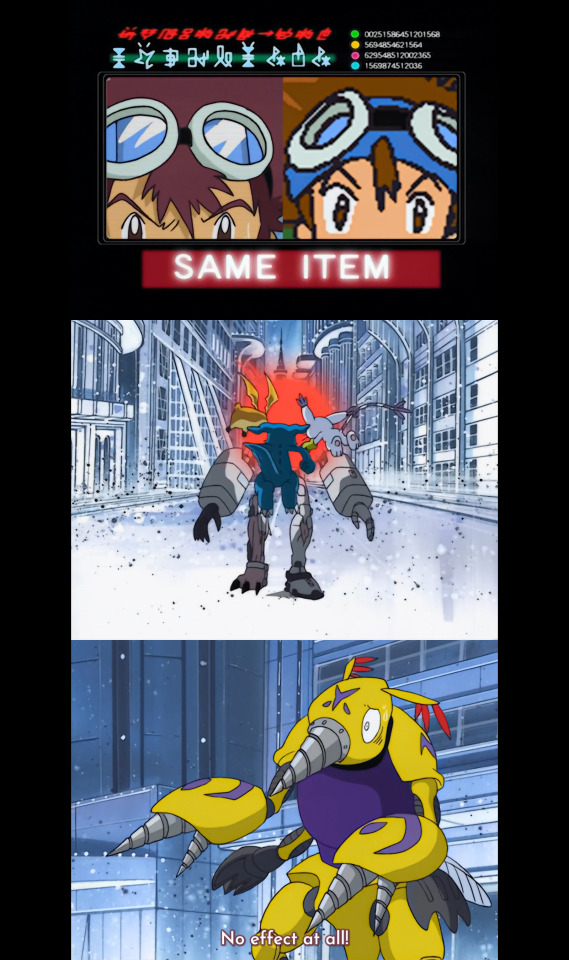
Daisuke: What are you doing!? We have to run!
As he approaches, Andromon's scanner notices the goggles on Daisuke's head. His database pulls up an image of Taichi to compare. It concludes "SAME ITEM". Andromon suddenly stops, hesitating to go any further.
Tailmon: NOW!!!
Patamon, Veemon, and Tailmon lunge for Andromon together. He makes no attempt to defend himself. The moment before they reach him, a red beam from the sky strikes him in the chest, knocking him off his feet. The other Digimon pile on top of him, helping gravity to bring him down.
Veemon & Patamon: WE GOT HIM!!! Tailmon: That beam just now....
Only Tailmon was paying attention. She looks to the sky to find the source of that shot: Horusmon flying in to the rescue.
Horusmon: FLAPPING LOVE, HORUSMON!!! Digmon: TADAAAAAAA!!!
Digmon erupts from the earth nearby.
Digmon: With full belly and full power, it's Digmon-sama dagyaa! Here we go! GOLD RUSH!!!
Full of arrogance, Digmon fires off all drills. While Andromon stands up, Digmon's drills bounce so harmlessly off Andromon's metal hide that he doesn't even flinch.
Digmon: Gyehhhh... No effect at all!
Andromon's power ruined Digmon's cool entrance. XD This is karma for the kanpyoumaki.
In the dub:
Davis: As much as I like you two arguing, he's heading right for us! (Andromon notices Davis's goggles and hesitates) Gatomon: LET'S GO!!! (Halsemon's shot and the Digimon's tackle knocks Andromon off his feet) Veemon & Patamon: Yeah! Gatomon: Here comes help now! Halsemon: (soaring in) I'm glad we're not too late. Digmon: Hi, guys! I thought since I was here, I'd build this city a subway system! Hold still, you pile of scrap metal! GOLD RUSH!!! (No effect) Digmon: Hey, that comment about scrap metal was just a joke!
Digmon is too busy quipping for the tragic showmanship of his Japanese counterpart.
Taichi and Iori come running up the street.
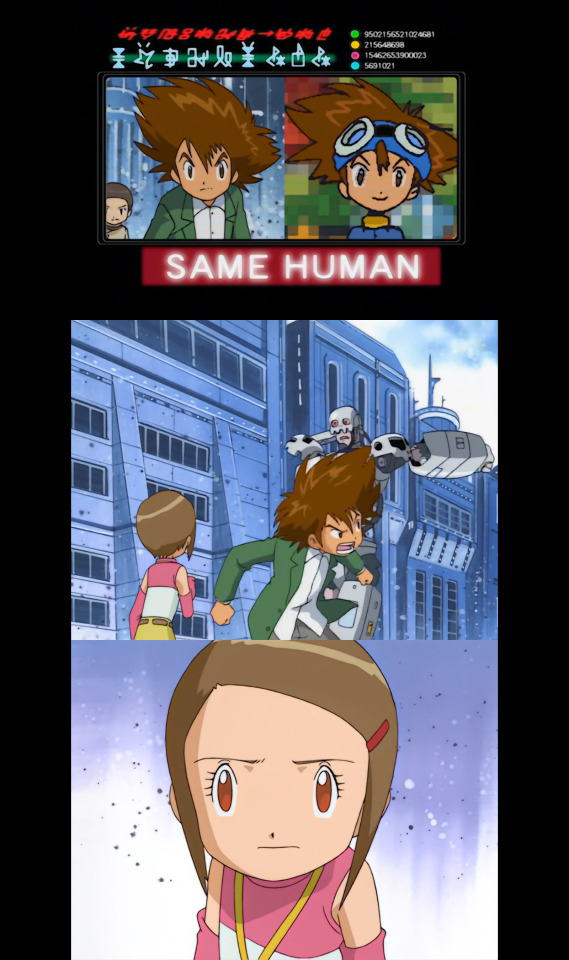
Taichi: HIKARI!!! ARE YOU OKAY!?!? Hikari: Onii-chan, it's Andromon!
On Taichi's approach, Andromon begins scanning him too.
Taichi: Andromon, it's me! It's Taichi! Andromon: (hesitant) ...Taichi....
His scanner pulls Taichi's image out of his databank once more and compares, before concluding "SAME HUMAN".
Suddenly, the Evil Ring around Andromon's neck activate blips. The sigils carved in it pulse red for a second, with an audible beeping sound, and the Ring crackles with electricity. Andromon cries out in pain and marches forward, swinging his arms.
Taichi scurries away from the attacking Andromon but Hikari stands her ground. He stops when he reaches her, staring her down, and Hikari stares him down right back.
Hikari: ... Andromon: ...
For the next ten seconds, Hikari and Andromon remain in a silent deadlock.
In the dub:
Tai: Kari! Are you okay! Kari: Yeah! But Tai, it's Andromon! (Andromon scans Tai) Tai: Andromon! Slow down! It's me, Tai! Andromon: Tai who? (Scanner matches Tai) Andromon: Oh, Tai! (Dark Ring activates and makes Andromon attack) Davis: KARI, LOOK OUT!!!
Thanks, Davis. Tai/chi rolled a 1 on his Onii-chan Save when he scurried away and left Hi/Kari right in the path of violence. But at least his kouhai Davis was watching out for her. From a safe distance.
The Crest of Courage!
(In seriousness, it's kind of amazing how we have three separate people ready and willing to throw themselves recklessly into danger to protect Hikari on-hand right at this moment. And yet, not one of them even tries to physically move her away from Andromon for this entire scene, with Taichi even leaving her behind when he flees Andromon's attack.
Hikari's putting off an impenetrable aura of "MY GODDAMN SCENE, ASSHOLES" that even Courage must yield to.)
Though they give Davis that one extra line, the dub lets those tense ten seconds of silence pass uninterrupted.
Andromon finally breaks the stalemate, grabbing Hikari by her shoulders and lifting her up.
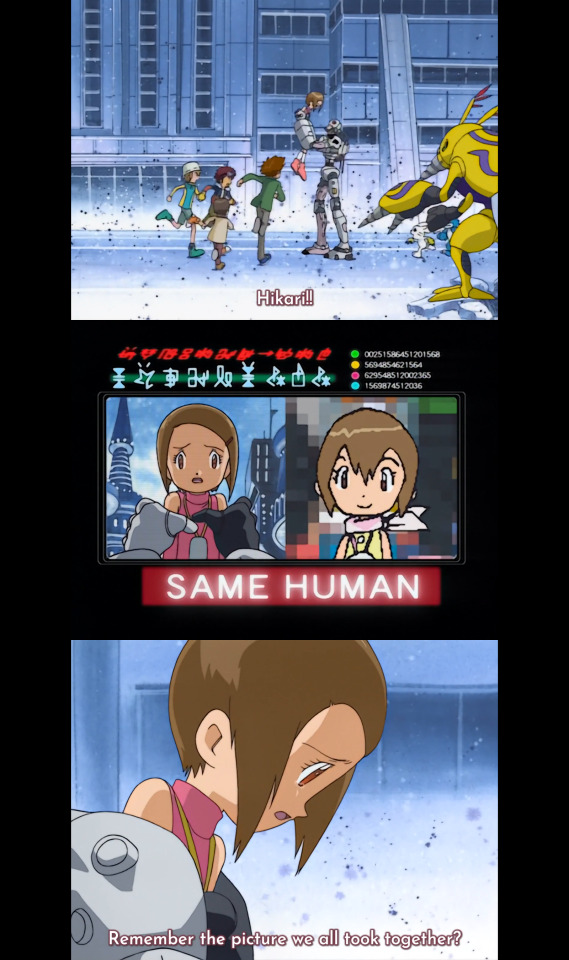
Taichi: HIKARI!!! Tailmon: WAIT!!!
The second Hikari's feet leave the ground, everyone tries to jump in. Taichi, Daisuke, Takeru, and even Iori all move at once, surging towards Andromon. But Tailmon's warning cuts them off. She wants to let this play out.
With the gentle tones of the original OVA theme playing out, Hikari keeps staring into Andromon's eyes.
Hikari: Andromon? Andromon: ...Hikari...?
Andromon's scanner finds her image too.
Hikari: (teary-eyed) We took a picture together, didn't we?
A tear falls from Hikari's eye, landing on Andromon's face. In that moment, the rest of the image he's been drawing up appears around Taichi and Hikari. Though blurry and pixelized, it's unmistakably the vague impression of that photo they took on the Children's last day in the Digital World.
Andromon: A picture....
In the dub:
Boys: Huh!? Gatomon: Hey, you put her down now! Kari: Do you remember me? Andromon: I am... trying.... (Scanner matches Kari) Andromon: Yes! Kari: (teary-eyed) We all took a picture together Andromon: ...a picture....
The dub has Gatomon yell at Andromon instead of stopping the boys. This change disrupts the action of the scene. We see them rush for Andromon and then... nothing comes of it and we move right along to Kari's emotional moment.
What happened to the boys? Why aren't they trying to intervene, when we saw them doing that a second ago?
Andromon's close to breaking free, but he needs one more push. Hikari's Digivice falls from her pocket. Glowing with holy light, it hits his shoulder as it falls and breaks the dam.

Andromon: That's right... We all... took a commemorative photo....
Piece by piece, the photo in his memory fills in. Despite the Evil Ring, Andromon remembers.
Andromon: ...I've been under the control of this thing.
Now fully in control of his faculties again, Andromon reaches up and breaks off his own Evil Ring.
Hikari: (happy) Andromon! Andromon: (nods)
In the dub:
Andromon: Faces... long ago... DigiDestined... I love jigsaw puzzles... Now I see the complete picture! (Andromon returns to normal) Andromon: Kari! I'm sorry for the trouble I've caused. (Andromon breaks off his own Dark Ring) Kari: (happy) Andromon! Andromon: (nods) Mhm!
Every time I feel like there isn't enough dialogue for a section, we get a line like "I love jigsaw puzzles". Abridged Parody-ass line awkwardly undercutting the emotional moment with quipping.
Andromon is free, but the city isn't. He turns his fury on the Kaiser's obelisk.
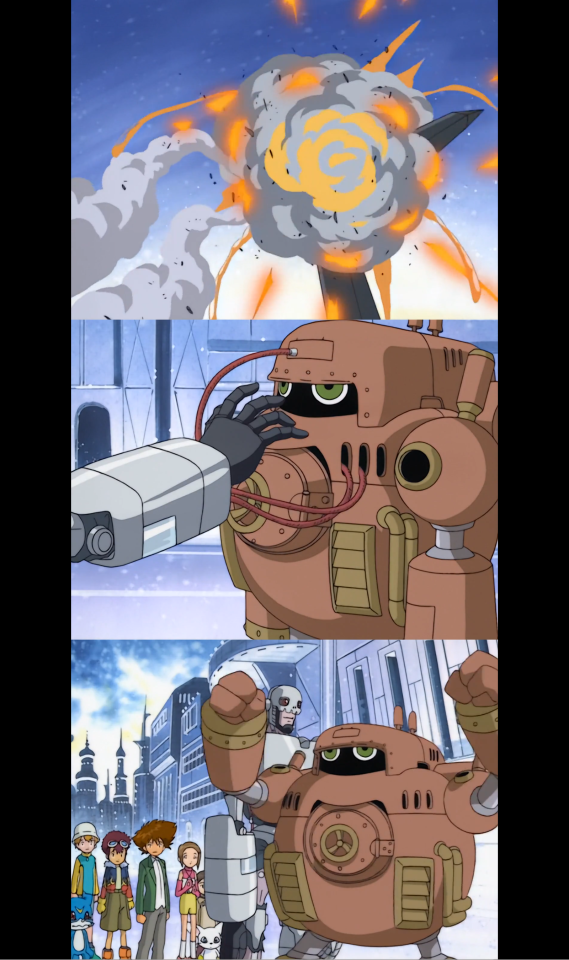
Andromon: Dark Tower... How dare you do this to us!? GATLING MISSILE!!!
Once more demonstrating the difference between Perfect strength and our own, Andromon's Gatling Missile rips the Tower apart in a single shot. His missiles impact the center, not only snapping off the upper portion but knocking over the lower section from the force of impact. The Tower crumbles beneath Andromon's power as easily as Fladramon and Pegasmon did.
With the signal to their Evil Rings lost, all Guardromon units in the city shut down.
Hikari: Hey... Are the Guardromon going to stay broken like this? Isn't there a way to return them to normal? Andromon: They're fine. We just need to restore the programming that the Evil Ring altered. Then they'll revert to normal.
Andromon demonstrates, first punching off the now useless Evil Ring from a Guardromon, then reaching his cables inside to reconfigure the unit.
Andromon: And then we will never allow the Kaiser to have his way here again. We will protect this city.
Andromon finishes with this unit. The Guardromon springs back to consciousness, raising their fists in jubilation at being free.
In the dub:
Andromon: That Control Spire is responsible for all this. Well, no more! GATLING ATTACK!!! (Andromon easily annihilates the Dark Tower) Kari: Andromon, are all of these Guardromon going to stay broken forever? Andromon: No. Their programs were rewritten by the Digimon Emperor. They just need to be reprogrammed. Watch. (Andromon punches off a Dark Ring and reprograms a Guardromon) Andromon: Actually, once I reprogram the Guardromon, I'll stay here to protect them in case the Digimon Emperor returns. (Andromon finishes) Guardromon: I feel fresh as a daisy!
The dub takes its third commercial break here, with that proclamation.
Dub Andromon doesn't seem quite as outraged as his counterpart, but this is nonetheless pretty close to original.
The Chosen Children return to Computer Club, only to find an angry Koushiro waiting for them.
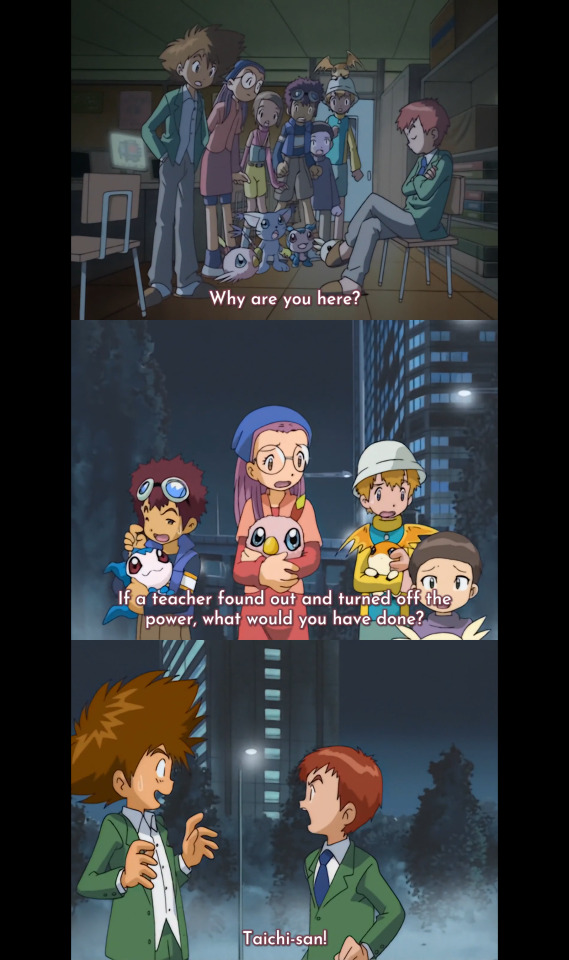
Miyako: Izumi-senpai!? What are you doing here!? Koushiro: Shh! be quiet!
Koushiro and Taichi escort the junior team out of the building. When they reach the gate, Taichi checks to make sure it's clear before they all emerge into the night.
Koushiro: (increasingly angry) Yamato-san told me what was happening. I checked the Gate Sensor on my computer, where I saw that the Gate was, in fact, still open! And if a teacher came in and shut off the power, WHAT WOULD ANY OF YOU HAVE DONE THEN!?!?
Been screwed. They would have been screwed. None of them have an answer, and they all look sheepish as they follow. Except Hikari, who is offscreen during this scolding because she didn't make the reckless choice send the full team in and hold no one back.
Taichi: Heeeeey, I think that's enough. Really, you just wanted to go too, huh? Koushiro: TAICHI-SAN!!!
That isn't technically a no, but no, I think Taichi missed the mark. I think Koushiro is mad for exactly the reason he's explaining here. This poor neurodivergent boy had to trespass in a dark computer room after-hours and babysit the computer for what might have been up to an hour or two. I'd be furious too.
In the dub:
Davis: Come on, guys! Let's go home! (Reality-crossing stock animation) Tai: Izzy, were you waiting this whole time!? (long pause) Izzy: Shh. Let's go.
There's an awkward silence where Miyako's supposed to speak, but one that makes sense. They forgot to animate lip flaps for Miyako during her line. I guess the dub decided not to have anyone speak when everyone's mouths are onscreen and nobody's lips are moving so that it doesn't look like an obvious mistake.
Instead, they move the line and have it spoken during the preceding shot, which is a closeup of Koushiro's angry face, freeing up other characters for dialogue.
This leaves a couple seconds of dead air where Miyako's line is supposed to go, in which nobody moves or says anything at all. Which is awkward but entirely the fault of the original scene for not animating Miyako's lip flaps.
Why they gave her line to Tai, however, I have no answer for.
Izzy: Matt just called and told me what had happened with Kari. And I'm really upset that you guys have left me out of the loop! Cody called Tai for help and Tai called Matt, but no one ever calls me until the adventure is all over with! Tai: Come on, Izzy. Don't be like that. There was just no time to call you. You know you're a big part of the team. Izzy: THAT'S RIGHT!!!
The dub takes Taichi's alternate explanation and runs with it. Izzy is furiously jealous to such an irrational extreme that he self-defeats his own argument.
Like. We have to briefly mention the fact that Tai did not call Matt. It's not clear how Matt found out but his conversation with Tai established two things: That Matt just sorta heard about this through the grapevine somehow but was under no expectation of participating, and that he did not hear it from Tai.
But setting that aside, Izzy makes three statements here:
1 - Matt called and told me. 2 - I've been excluded from the group. 3 - Because Cody called Tai and Tai called Matt but no one called me.
Um. Izzy, what the fuck are you on about? Sounds like you were the next person in the chain. If anyone's derelict in their communication duty, it's you for not passing it along to... Sora or Joe, I guess.
Incidentally, this alternate version of Izzy's anger makes the shot of the junior team looking embarrassed and ashamed super confusing. What are they ashamed of? They did nothing wrong here. Tai and Izzy are just... having a spat, I guess.
Suddenly, Koushiro remembers he had something else to talk to the team about.
[Pic]
Koushiro: Right. Earlier, I got an email from a friend of mine in America. I'd asked them to analyze the data from Miyako-kun's Digivice. The results are in. Taichi: A friend in America? Koushiro: They've helped me a lot in the past. Taichi: Ahh, I remember!
IT'S WILLIS
This feels like it's supposed to be a callback to Our War Game but, ironically, the only time an American friend was pivotal to the plot was in the dub. So far as I know, this American friend that Taichi also knows is never extrapolated on.
It can probably be assumed that they're part of Koushiro's hacking nakama from that OVA.
Koushiro: So, about Miyako-kun and the others' Digivices. (Each of them takes out their Digivices to look at them) Koushiro: It said, "Digital", "Detect", and "Discover". These words were found inscribed within the data. Because all three of them begin with the letter "D", we'll refer to them as D-3 going forward. We've also found some other interesting things, such as-- Chibimon: (stomach gurgle) I'm hungry, Daisuke! Daisuke: (stomach gurgle) Ah! (sheepish) Me too.... Taichi: Koushiro, we can talk about this tomorrow. We all desperately need to get home soon. It's way past dinner time! Group: AHHHHHHH!!!
The group disperses and runs for it. Every child for themselves!
In the dub, Izzy's still ranting about being excluded.
Izzy: And as a team member, I expect to be treated with the same respect I give to all of you! I may not be as strong as you or Matt, but I've gotten us out of just as many jams with my particular skills! Tai: (resigned) I'm sorry I didn't call you. Izzy: Now that's what I call respect. Okay, I forgive you. Tai: Wow, that was easy!
This fills the space where the discussion of Koushiro's mysterious American friend goes. Kind of a shame because we're about a month out from the release of Digimon: The Movie so this would have been a golden opportunity to shill Willis and whet the audience's appetite. XD
Izzy: Oh, I almost forgot the reason I came here. I examined the new Digivices-- (Everyone takes out their Digivice) Izzy: --and determined that they have three different settings: Digital, Detect, and Discover. Maybe we should call them D-3s from now on. Prodigious little devices, aren't they? I had a lot of help with the research from my friend Willis in America. Maybe you guys will meet him some day.
NEVER MIND, THERE IT IS
Good job, Dub Team. No marketer worth their salt would ever let a golden opportunity like this pass them up.
Izzy: Anyway, I think the D-3s might have sent a message to Andromon's memory banks which then made him--AUGH!!! DemiVeemon: Please finish talking after we eat! Davis: HUH!? Ugh, we forgot about dinner! Tai: That's right! Our parents are waiting for us! The food's probably cold and soggy by now. Of course, for my mom, that's an improvement. Let's go!
The curse of the missing sound effects strikes again. Nobody's stomachs rumble, which leaves Izzy suddenly reacting to nothing in particular. DemiVeemon's line at least flows into Davis's without the gurgle. There is a sound for him, but it's a wacky spring sound to signal his distressing realization.
Fortunately, they still managed to make Izzy shut up about whatever he's wrong about now. XD No, Izzy, the D-3s did not "send a message to Andromon's memory banks".
Meanwhile, poor Yamato is already home and desperately trying to finish that dinner he promised.
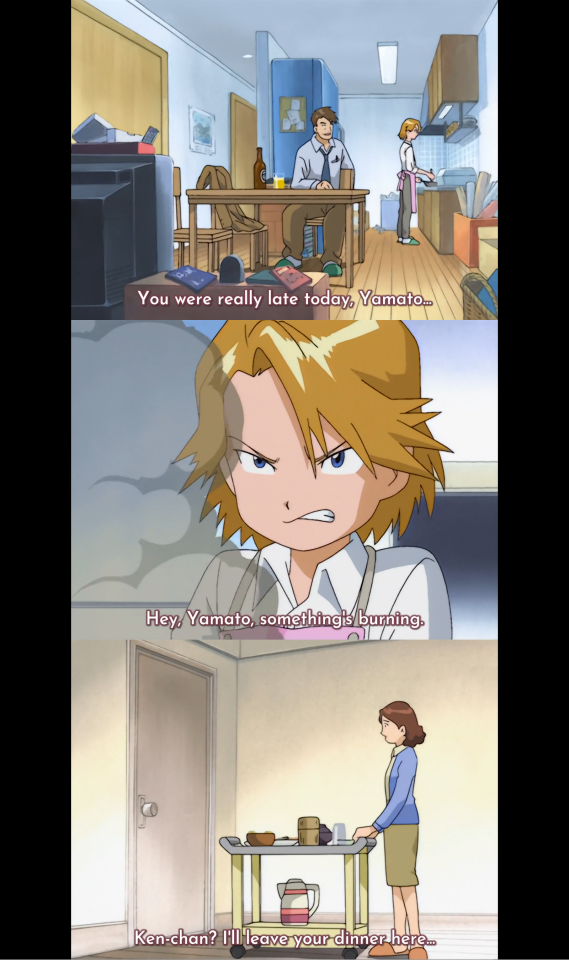
Hiroaki: You're awfully late today, Yamato. If I'd known, I could have gotten something while I was out. Yamato: It's fine. I'll get it made.
The nagging won't get it cooked any faster, Hiroaki. I'm starting to understand why you're divorced.
Hiroaki: Oh, did something happen? Yamato: (fuming, thinking) I have to go on a date! Daisuke, you owe me big for this one. (Smoke begins to rise from the pan while Yamato's not paying attention) Hiroaki: Hey, Yamato! Something's burning.... Yamato: (snaps out of it) Huh!? Oh, crap!
Never mind, Hiroaki. Nag away. You lose the high ground when you set the apartment on fire.
Across town, Ken's mother wheels Ken's dinner to his room on a fucking cart.
Mother: Ken-chan? I'm leaving your dinner here.
As if this is simply routine, she leaves the cart outside Ken's door and leaves.
Inside Ken's room, he's already returned from the Digital World. He sits in the dark, illuminated only by the glow of his monitor, and stews.
Ken: So then, to control them at Perfect-stage... Does this mean the Evil Ring is insufficient?
We leave the episode here, with Ken pondering the results of this recent trial run. I'm sure good things will come of this.
In the dub:
Hiroaki: Some girl named Jun called today, Matt, and she said you had a date with her on Friday. She wanted me to tell you that she made dinner reservations for you two at Morealis (???). Matt: Morealis? What's that? Hiroaki: The most expensive restaurant in town. Matt: (fuming, thinking) This is all Davis's fault. I can't believe I have to take his sister out on a date! Hiroaki: Hey Matt, something smells great! I'm getting hungry? Matt: (snaps out of it) Huh!? Uagh... dinner's ready!?
Dub Jun is incredibly proactive. Holy shit, she is milking this for all it's worth.
The dub leaves the audience to infer the state of dinner, based both on the massive amounts of smoke and Matt's horrified reaction. XD
Ken's Mother: Supper time! Ken, dear! You're busy. I'll leave it outside your door! (Ken's mom leaves the cart; Cut to interior) Ken: Blast, those Digivices are becoming a nuisance to me! I've gotta get them away from those kids! Narrator: What is the Digimon Emperor's plot against the DigiDestined? Find out next time on Digimon: Digital Monsters!
And we close the dub with one last scrubbing of all mention of Perfect-stage Digimon.
Implicitly agreeing with Izzy that the D-3 was responsible for the Andromon incident, Dub Ken schemes to strip the DigiDestined of their Digivices. That's not what's driving the plot forward though so we'll see if that gets followed up on or not.
Also, his mom is much more upbeat and positive about the cart thing. In contrast to Japanese Mama, she makes it sound like she's actually expecting Ken to come out at first.
Assessment: Okay. So. I need to go off about this.
The fun thing about the triangle dynamic between Daisuke, Takeru, and Hikari is that Takeru and Hikari have a close friendship but not one that is necessarily romantic. Though one that absolutely could be romantic, and the creators are not shy about teasing them as a ship. See above, re: Takeru's hand in shippy places in the back of that one shot.
But while certain other pairings absolutely do close off into canon coupling, Takeru and Hikari remain ambiguous, and that makes the dynamic with Daisuke so much more interesting. Daisuke is jealous of the close bond Takeru and Hikari have right from the start, but misdiagnoses it as Takeru and Hikari coupling up.
While we, the audience, know exactly what it is. Whether or not there are romantic feelings involved is irrelevant. What Daisuke's jealous of is Takeru and Hikari's bond of shared experiences that no one their age could possibly understand or relate to. They went to war together. They dangled from that rope over Piemon's observatory together.
Hikari is not interested in Daisuke romantically. But that disinterest is unrelated to whatever feelings she may or may not have for Takeru. Whether she does or doesn't, she doesn't need to have feelings for Takeru to not want to go out with Daisuke.
Daisuke declared Takeru to be his love rival on day 1, to Takeru's eternal confusion. Daisuke thinks this is a love triangle. But what's really going on here is that Daisuke is shadow-boxing Hikari and Takeru's fire-forged bond of mutual trauma. And losing.
This episode really emphasizes how much of a rookie Daisuke is. Both in terms of his understanding of Digimon metaphysics and also with the core dynamics of the Chosen Children nakama. He is very much The New Guy, a position he chafes at.
Nonetheless, despite spending a decent chunk of it on Takeru and Daisuke, this episode is about neither of them. It's about Hikari and, specifically, how much she means to the people in her life due to her strength of will and force of personality.
It's a combination of factors that make the Evil Ring break down.
Perfect-stage Digimon are too powerful to reliably be controlled.
Hikari weaponizing her relationship with Andromon to compel him to resist.
Hikari's intrinsic holy light, channeled through her Digivice, doing what it used to do to Black Gears.
All three of these factors together resulted in Andromon's unprecedented moment of willfully breaking free from the Kaiser's control device.
This was only possible because Andromon is Perfect, but this was Hikari's victory.
25 notes
·
View notes
Text
youtube
Discover how small merchants can harness the power of data without getting overwhelmed, and learn about Buyist Pro's innovative AI-powered platform that can analyze complex eCommerce data in seconds. Greg shares real-world examples of how AI can identify issues affecting conversion rates and explains why recurring revenue models are becoming crucial for eCommerce success in today's competitive landscape. Whether you're a small business owner or eCommerce entrepreneur, this episode provides valuable insights into the future of AI-driven eCommerce solutions.
Chapters 0:00 Intro 0:45 Using Data in eCommerce 1:30 Buyist Pro AI Data Tools 5:03 AI in eCommerce 6:50 eCommerce Trends in 2025
21 notes
·
View notes